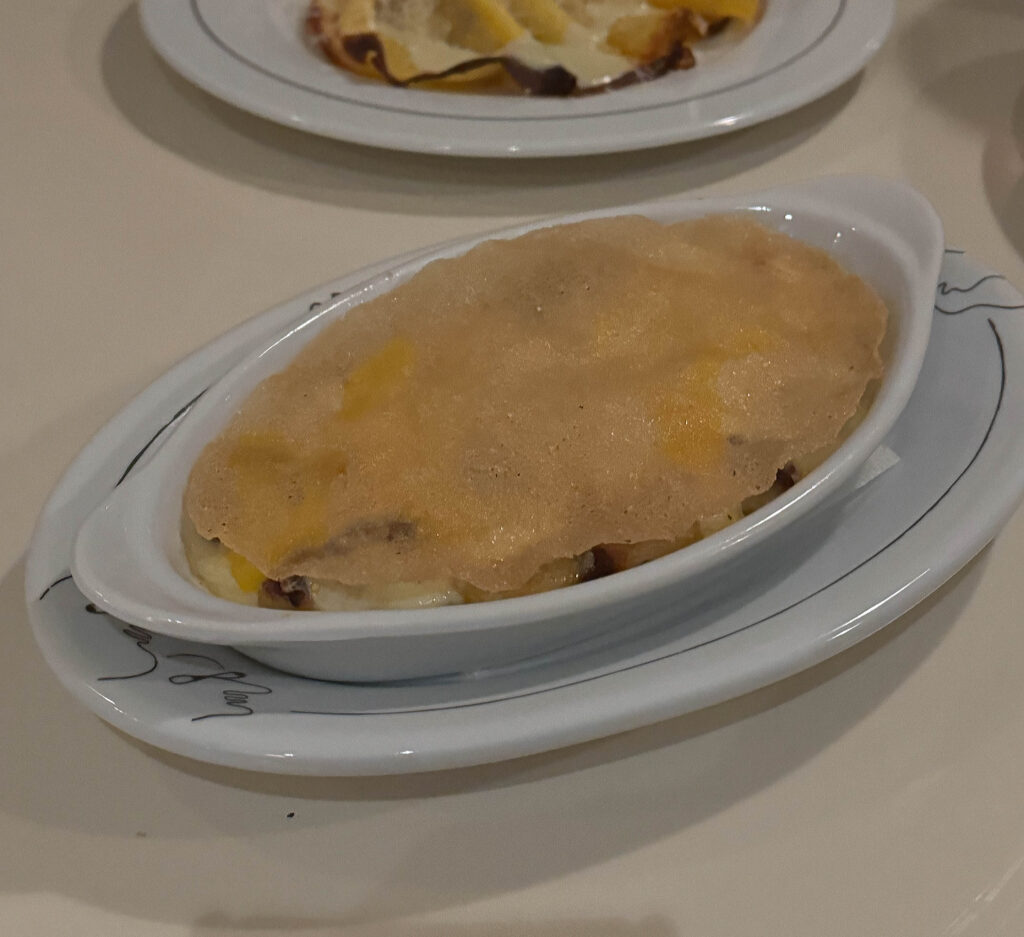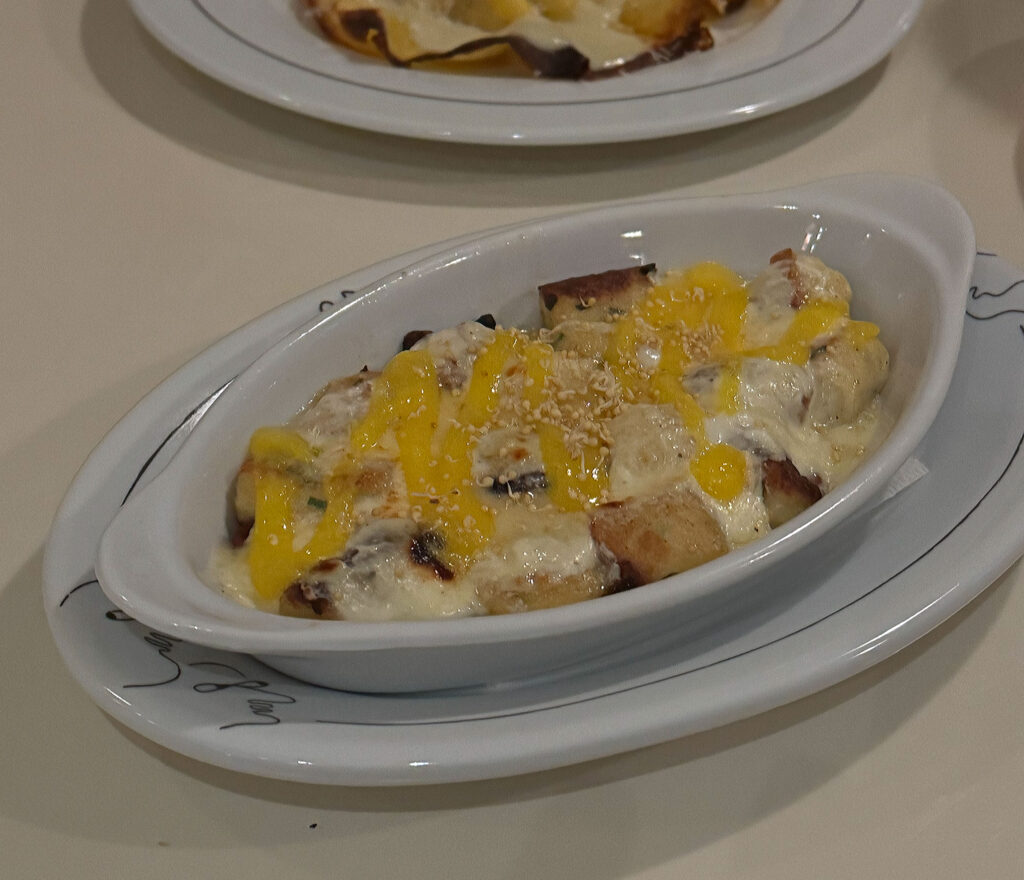When it comes to new openings, this year in Chicago dining has been a bleak one: more steakhouses (tapping into what few gimmicks remain untouched), more omakases (some now shying away from nigiri altogether), more tasting menus (from chefs holding dubious credentials), and the occasional relocation.
To be clear, I actually enjoy a couple of the concepts I am hinting at. But other examples within these categories leave me ruing the city’s stasis—maybe even regression—despite its reputation as a national or international food destination. That’s my view from the top at least. And, while it goes without saying that there’s much more to eating than fancy, sit-down restaurants, this is the caliber of dining (newly democratized) that most captures the public imagination in the present day.
After all, American culture is obsessed with “the best,” and consumer behavior follows. There’s a whole Michelin Guide worth of starred restaurants for budding gastronomes to visit before they need even think of getting bored. Factor in that trickle of new openings (easy fodder for content creators eager to dub new “bests” of a certain month or year), and it really seems like there’s no reason for alarm.
Dining room to dining room and dish to dish, there’s always something exclusive, expensive, and glamorous to show off. Even a first-time visit to Alinea, some 20 years on, is sure to impress all but the most jaded, cynical souls in a given milieu. Yes, social capital—more of it than ever—stands waiting to be seized by anyone who wishes to style themselves as a person of taste.
When one digs deeper (beyond what restaurants may offer as a mere signifier of status) and pursues this hobby to some maddening extreme, the character of “the best” changes. Really, it collapses altogether. The limits of Bibendum’s expertise become apparent: he’s writing his guide for a lowest common denominator of international travelers, aligning with certain longstanding expectations of luxury, with little care for how a city (no less a new generation of consumers) sees itself. But least Michelin is shrewd enough not to try and put its restaurants in a ranked order, a conceit (no matter the methodology) that is diametrically opposed to artistic expression.
Eventually, instead of looking outward—toward authorities who only shape a common knowledge of desire—one trusts that inner voice. Personal preferences (for the “best” preparation of a favored dish, for a wine list that scratches a specific itch, for the kind of setting that speaks to one’s soul) are honed. The pall of exclusivity, that pernicious “velvet rope effect,” is robbed of its power. There may even be an acknowledgement that spectacle, rather than fine food, may be exactly what a particular party on a particular night needs.
Somewhere on the other side of all the bragging rights, meals forgotten, and luxury ingredients one has grown to hate, a different way of seeing takes hold. One breaks from the crowd (and the rewards of echoing its taste) in order to gravitate toward those voices that seem to only be speaking to them. As with all deep engagements with art, the particular suddenly overshadows what was seemingly universal—only for that same particular, by plunging deeply enough into what’s personal and singular, to become (by the very process of unbridled self-expression) universal again.
For the experienced diner, the “best” restaurant (really, a “best” restaurant) is the one whose personality deepens with each successive visit. I’m not talking about seasonal menu changes. I mean an establishment whose place within the tapestry of the city, the country, and the world’s greatest concepts grows ever more distinct. I speak of a connection—inspired by some philosophy, rooted in hospitality, actualized through the food, but infusing every inch of the experience—that reveals new facets no matter the number of encounters.
A restaurant of this caliber—so comprehensive, so alive—crowds out its peers. It may have one or more (or no) stars to its name. But it stands ready to meet the evolution of one’s palate (as well as those few parts of it that never change) once other places, with their diminishing returns, fall by the wayside. It shines in a way, time after time, that revives one’s earliest love of dining (so worn thin by the shame and misadventures that such a gratuitous, consumptive pastime naturally entails).
Elske is one of those restaurants, and Creepies, which announced itself (and later opened) with what seemed like a congenital aversion to hype, effectively doubled the Poseys’ capacity for creative expression after nearly nine years of patient, boundary-pushing work.
The new concept has already been received as a breath of fresh air: not only for a West Loop that has increasingly tilted toward mass—even chain—concepts, but also for a city whose independent restaurateurs (even those touting the highest of honors) have so rarely been able to expand, empower their talent, and build on the goodwill they have earned.
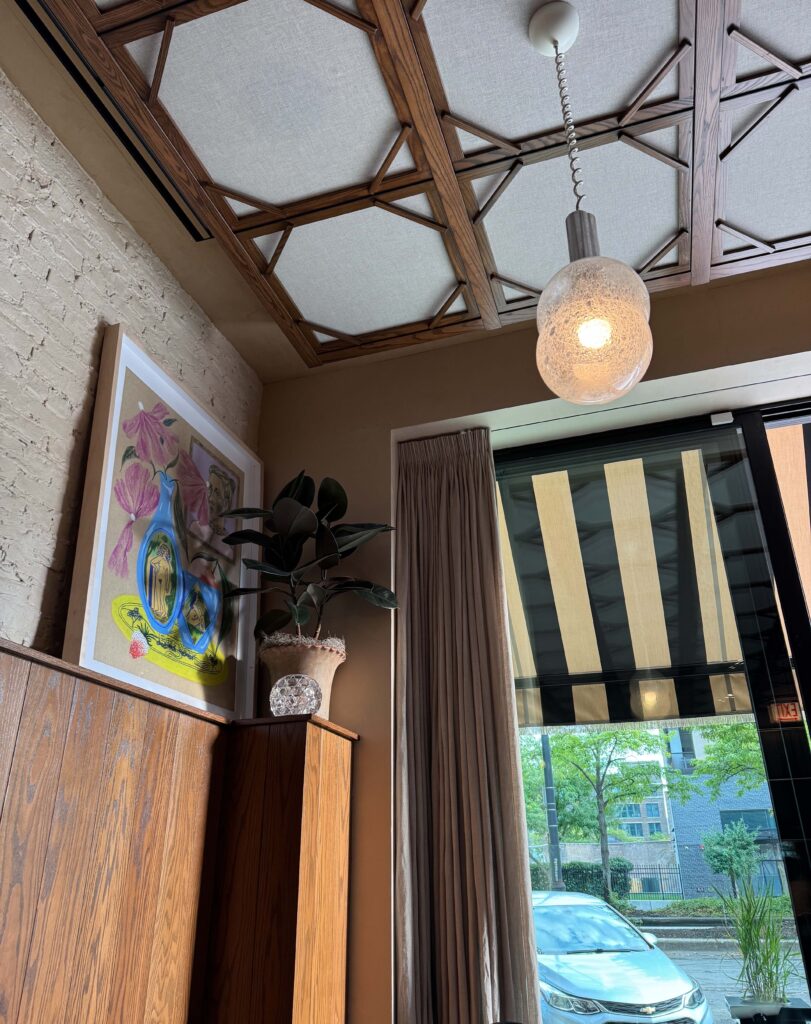
Creepies launched its Instagram back in 2021 with nothing more than some cryptic cartoon faces—the titular “creepers” (created by Jenny Volvovski) that take their inspiration from the “Kilroy was here” doodles of the 1940s (“a favorite of Anna Posey’s grandmother”).
When I stumbled across the page many years later, it was impossible to tell what these squiggles—still so central to the design (no less the attitude) of the restaurant—represented. But it was clear, based on who was following and being followed by the account, that the Elske team was involved.
The Poseys “had always hoped to open a more casual neighborhood spot” that “you’d want to go to, hopefully once a week.” They joked, “let’s find a dingy little creepy building somewhere and open up this small spot.” The space located just across the courtyard from Elske (home to a catering company and event space) was long viewed as an “ideal” option. In the wake of the pandemic, it became available.
Adapting that offhanded “creepy” descriptor into the restaurant’s namesake, the chefs patiently put the rest of the details in place. David had “always…been drawn to” casual French cooking, and it was natural to blend that style of cuisine with “the flavors of the Midwest” in a shareable format for the savory food. Anna’s work, on the pastry side, would similarly draw on French ingredients and techniques while translating them (with seasonal touches) in the same singular, acclaimed style shown over at Elske.
The Poseys would choose Tayler Ploshehanski—whose credits include Blackbird, Wherewithall (as chef de cuisine), and Elske (as sous chef)—to be their principal collaborator. Now chef de cuisine of Creepies, she would lead the effort to make “people…feel completely comforted when they eat the food” by balancing the same mind-blowing flavors of the Michelin-starred mothership next door with a prevailing sense of approachability and “love.”
With bar manager Monica Casillas-Rios and wine director Emily Sher of Elske also lending their expertise to the concept, the opening seemed poised to be a breakout success: channeling a breadth of talent the city had already come to know and admire toward an even friendlier, mainstream expression of gastronomy.
I was there at opening on August 22nd, and Creepies seemed to have immediately fulfilled its potential. Out of nowhere (despite many years of quiet planning), Chicago dining had been given a shot in the arm. It was the kind of restaurant—almost like our answer to The Four Horsemen—I had long dreamed of: intimate and warm, a bit zany, with a short but sweet (but intelligent, evolving) selection of beverages and a distinctive, playful, yet pinpoint execution (or maybe subversion) of familiar fare.
I was dying to return, and I did so in early September: trying the entirety of the menu this time but finding the food (especially dishes I had already come to know) less convincing. No recipe could be called a downright failure—indeed, it was easy to appreciate the thought process underlying each preparation. However, textures, once sharp, were now dull or soggy. Flavor combinations landed more on the weirdly unsatisfying—rather than weirdly compelling (and thus unforgettable)—side of the spectrum.
I felt deflated. This is a genre (so timeworn, so iterated) in which chefs must undoubtedly please before they look to rewrite the rules. Why consciously embrace the title of “neighborhood bistro” only to take experimentation too far and totally scuttle those expectations?
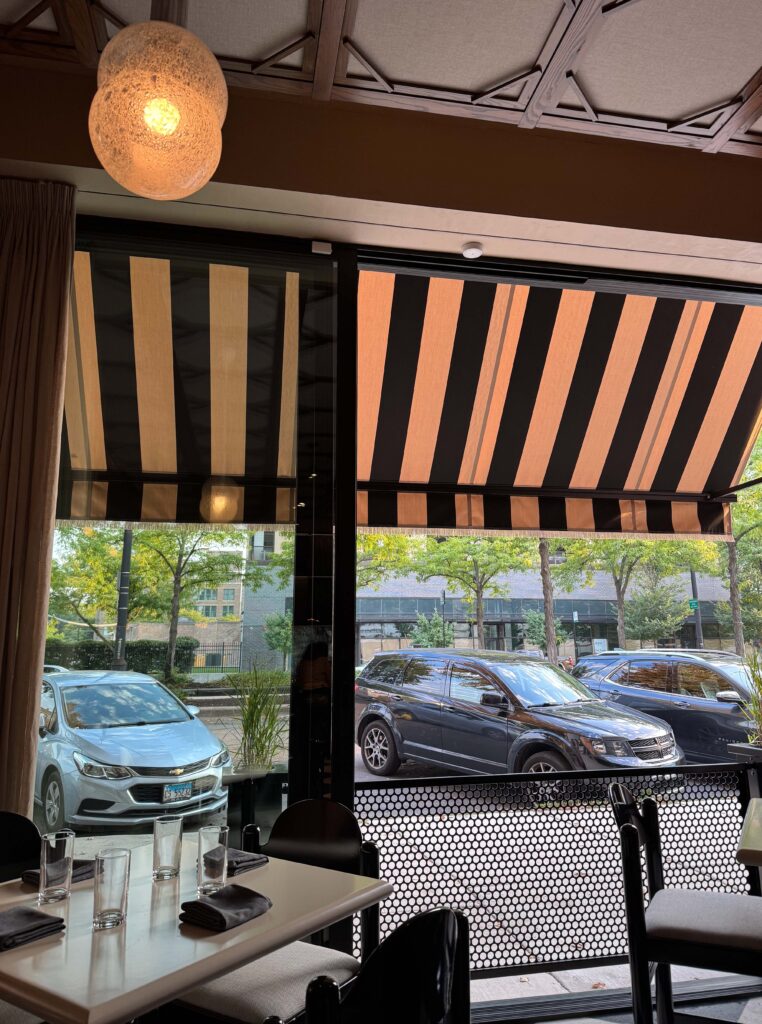
I reminded myself that Creepies was a young restaurant. It wouldn’t be the first to be dogged by inconsistency, and, more importantly, I knew the heights the kitchen was capable of reaching. Plus, other diners were having positive experiences, and the concept’s reputation was growing. Did I catch them on a rare off night?
I returned again in mid-September with an eye toward trying the best and the worst of the dishes I had previously encountered. That night, there were a few clear successes matched by an equal number of clear disappointments. The majority of items continued to land in that average to merely good stratum of quality: that is to say, they were interesting but uninspiring.
I was confused. Clearly, my last meal was no fluke. Certain recipes had still not regained the level of quality I tasted on opening night. Were the others, which I never seemed to like, conceptually flawed? Or had something happened operationally in these first few weeks (something as simple as struggling to maintain standards in the face of popularity) to inhibit or undermine the work of the kitchen?
By then, hype was brimming, and Creepies was beginning to be saddled with that pernicious word: “best.” My opinion seemed to be in the minority, yet the occasional commentator echoed it—they found a lot to like here, but many dishes were far from distinguished.
Others seemed happy to make the rounds, eagerly celebrating a pedigreed concept that looked and felt different than anything else that had entered the market. Certainly, even at its worst, Creepies was putting forth food with a degree of novelty and value that was starkly missing from some of the city’s latest, glitziest openings. By comparison, it was a small, knowable restaurant worth rooting for.
But, relative to Obélix, Cellar Door Provisions, Maxwells Trading, The Loyalist, or Elske itself (to name a few places with competing value propositions), was it really worth visiting—yet? How tenderly should one treat a new restaurant, and how loudly should it be praised merely for being new, when one knows the high standard that the parties involved are capable of achieving?
In all fairness, it’s foolish to say anything decisive about a place that hasn’t even been open for two months. Nonetheless, it might be worthwhile to grapple with what’s working and what’s not at this early stage. Meaningful feedback, rather than flattery, is what will catapult Creepies to the mountaintop that it seems, structurally, so well equipped to reach. Moreover, an acknowledgment of imperfection might help realign the expectations of visitors who, encountering flaws, chafe against what they view to be unearned, deafening hype.
In truth, my fourth encounter with Creepies (in late September) signaled that the kitchen may already be improving its execution. Thus, for the sake of painting a fuller picture of the concept, I will present my observations from the past two meals in this one piece. Doing so, I hope to pay respect to what has changed while also highlighting some persistent sticking points.
Whatever those may be, future visits (well past the two-month mark) will offer further opportunity for the team to shine. In the meantime, can only be rewarding to consider where exactly they started from.
Let us begin.

I’ve long said (in a somewhat tongue-in-cheek manner) that a solitary stretch of Ada Street, between Lake and Randolph, is home to Chicago’s finest dining. Yes, one need not venture further north (where another tasting menu lurks) or consider the myriad restaurants that lie to the east. One need not play the game of deciding which one- or two- or three-Michelin-star concept is actually the “best.”
Rather, in Smyth and Elske, diners find kindred experiences: gastronomy conducted with a rare ease, serving cuisine with a singular voice, pairing wine nobody else dares to pour, displaying even something of a stylistic overlap, but occupying two opposite ends of the value spectrum. It would be easy to juxtapose either one of these meals with comfort food (like the burgers or chicken nuggets they respectively serve).
But, in conversation, as two establishments looking to balance risk-taking and pleasure and self-expression in their own ways, Smyth and Elske really shine. They’re each the kind of place that waits at the end of the road of connoisseurship—the type that seems to grow in estimation just as others begin to shrink. Yet the latter, offering à la carte, allows one to jump the line. It shatters the price barrier that keeps three-star cooking out of the wider public’s hands and allows almost anyone to enter the conversation (if they’re open-minded enough) instantly. Ultimately, this fosters an appreciation of craft that is untethered to superficial luxury, and it helps to cultivate a class of consumer who, when they do choose to splurge on dining, find more meaning in doing so.
Just as The Loyalist does (relative to Smyth), Creepies promises to adapt some of Elske’s savoir-faire for a mass audience. Given the residential towers that have sprung up around the block (joining a sprawling gym and the Plumbers’ Hall event space), the area feels ripe for more flexible, casual dining (no less from chefs who have built their reputation here). Otherwise, one can only find Coquette, Kaiser Tiger, Gyu-Kaku, a Small Cheval, and a McDonald’s in the immediate vicinity.

1360 W. Randolph, the “little creepy building” of choice, makes for a marked contrast with its neighbor. Elske is clad in white, curtained, and spacious—with a wall and a gate (and a gnome) guarding the lush garden (filled with well-dressed patrons and polite chatter) that forms one of Chicago’s most enticing entryways. Creepies, in turn, is anchored by red brick and black-and-white striped awnings. The restaurant’s windows (which double as sliding doors in this weather) open up to the sidewalk, inviting the energy of the street (defined less by the noisy flow of cars and more by dogs, gymgoers, and families).
Peering into the dining room, one finds a cozy, wood-trimmed space with patches of exposed brick and a checkerboard pattern lining the floor. These days, the space’s 66 seats (spread across banquettes, free-standing tables, and a narrow counter facing a mirrored wall) are invariably filled, so it’s easy to miss the smaller details that transform this seemingly timeless bistro space into something more offbeat and charming. I speak of wonky geometric upholstering, mismatched tiling, esoteric framings (one, a kind of reimagined still life by Laura Burke; another, a Bruce Lee Webb print), and knickknacks ranging from misshapen Simpsons characters and model food to rusted cookware and smug ceramic visages.
Yes, there’s a delightfully weird undercurrent to Creepies that one almost also perceives at Elske (but, there, would not be as appropriate to indulge). It helps to situate the concept, which works within a genre that has been preserved and reinvented (and, from time to time, totally bastardized) throughout the city’s confines, within its own context. It’s not just another “neighborhood bistro,” but a bistro for a neighborhood that two of Chicago’s finest, most proudly uncompromising restaurants call home.
Creepies is a beachhead through which this work—inward-facing and funky—reaches out to the street and the wider public and makes its presence known.
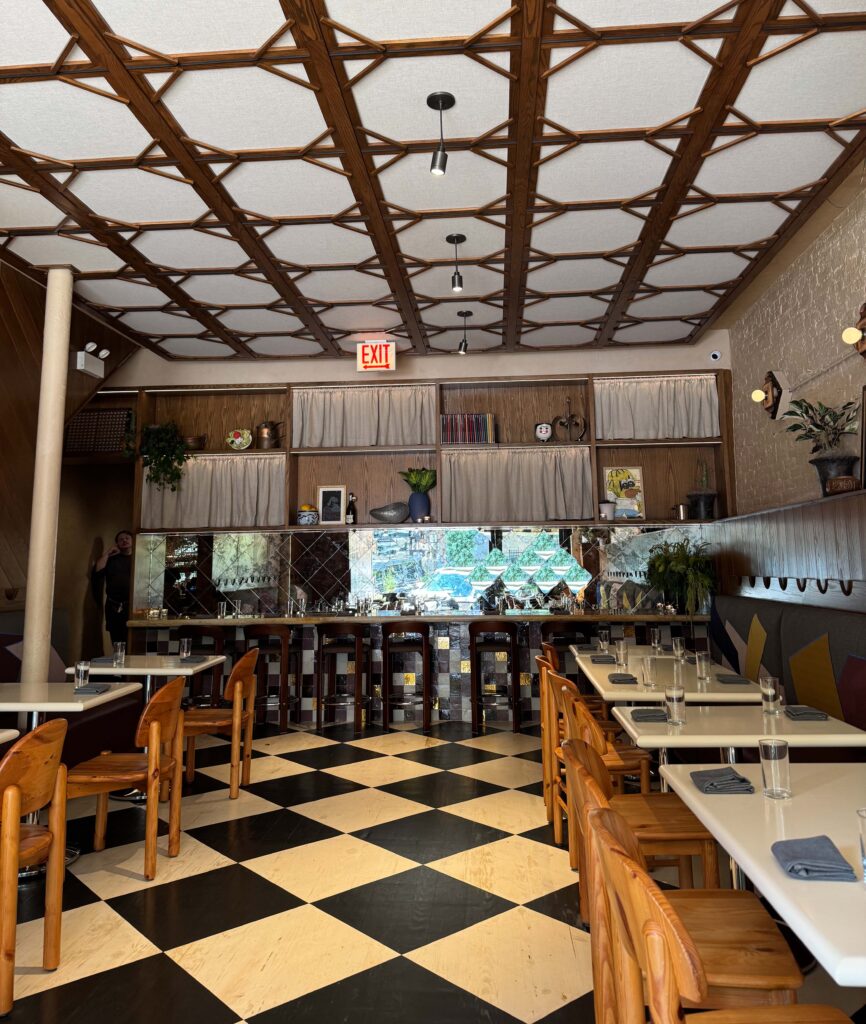
Approaching the host stand, I am met by a smile and whisked to my table with little more than a moment’s wait.
The dining room hums with conversation, but sound dampening ensures that, even at maximum capacity, guests have no trouble hearing each other. (During quieter moments, an upbeat soundtrack of oldies R&B, pop, and disco plays well off the décor.) Seating here, by the same token, has absolutely been maximized. However, there’s just enough space between tables to preclude any imposition (like the bumping of the chairs), and one can enjoy the sense of being lost in the crowd at a trendy restaurant without the associated drawbacks.
Indeed, the audience largely comprises the standard demographic of 30- and 40-something white couples that chase out new openings. But I’ve seen parties skew younger and older. I’ve seen fashionable Asians out on dates and groups of black girlfriends out on the town too. This diversity reflects the legibility and approachability of the chosen format, and the servers (aproned, often tattooed, sometimes adorned with shining jewelry) stand ready to show everyone the ropes.
I was left particularly entranced by one performance at an adjacent table: a spiel that held the attention of all six diners while confidently framing the style of cuisine (“it’s all about texture”) and offering wine recommendations to boot. Mechanically, the front of house also hits all its marks: refilling water (using the same doily system seen at Elske to demarcate sparkling), handling plates, and folding napkins attentively. Even wine service (including the identification of corked bottles) is handled with unerring precision.
With this sense of conscientious and ownership over the guest experience forming a foundation, the evening flows with a bewitching ease. Everyone seems to feel warmly hosted and happy to be here. I’ve even found (and this is rarely true given how cagey “foodies” get about staking their claim at the newest hotspots) a beautiful bonhomie between parties: as customers go out of their way to show interest in a chosen bottle of wine or ask for food recommendations.
Creepies, in short, has done a brilliant job of constructing the atmosphere and emotional underpinnings of their desired “neighborhood bistro.” Style may not always suggest substance, but the tone of this place and the spirit of the people who fill it have kept me coming back even in the face of occasional miscues from the food.
The beverage program, in the hands of Casillas-Rios and Sher, serves only to heighten this effect (perhaps unsurprisingly given the superlative quality of their work at Elske). But Creepies is its own restaurant with its own personality and its own corresponding constraints. What the two have built is not derivative or a mere simplification of what they offer next door; rather, the selection matches a different mood and style of dining while treating it with the utmost respect.
The “Mixed Drinks” might be the trickiest (but correspondingly impressive) part of the equation, for the restaurant does operate with a full bar (like the one Casillas-Rios tends at Elske). Instead, libations are generally blended from just two components, and patrons, if they’re bold enough to request a favorite that is not on the menu, will find the team lacks the capability to do much else.
In an age when craft cocktails are so coveted (often forming the lone highlight of concepts that are otherwise disappointing), I cannot think of a more challenging restriction to be faced with. I’m certain it was for a good reason—like maximizing seating and the functioning of the kitchen in a space that’s already small. But it also throws the gauntlet down: you’re going to drink the way we want you to.
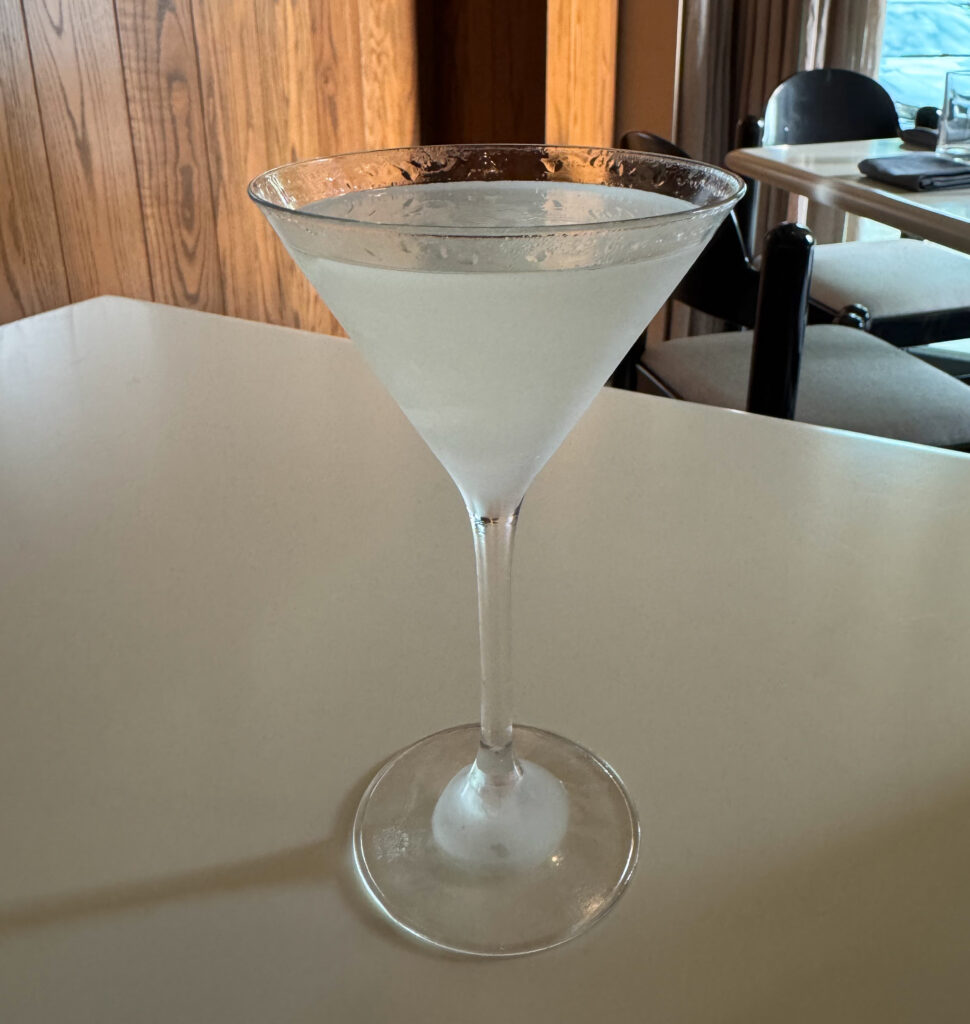
For my palate, the system works. First off, the drinks often arrive at the table in just a few minutes. Second, they generally taste great. A “House Vesper” ($16)—the most involved of the bunch (blending vodka, gin, Lillet Blanc, quinquina, and lemon oil)—is impeccably balanced: combining a sharp zestiness with lasting botanical sweetness. It ranks right alongside Casillas-Rios’s work at Elske as one of the best martinis in the city.
Of the simpler pairings, the ”Rhum JM + Lime Leaf Cordial” ($16) does well to match the honeyed, tropical notes of the spirit with brightness (reminiscent of a daiquiri) and a unique, haunting florality. The “Strawberry Amaro + Sparkling Lemonade” ($16), in turn, is a bonafide crowd-pleaser: invigorating the base spirit’s bitter, fruity tones with citric fizz. A canned “ISH Non-Alcoholic Paloma” ($12) can also be spiked with tequila ($4) to jerry-rig the real thing; however, the result falls short of the drink’s expected weight and vibrancy.
Still, I appreciate the effort to use all the resources on hand to please as many customers as possible. (That “Paloma” may not be equipped to challenge the finest examples, but it will certainly come to the rescue of someone who just has to drink tequila.)
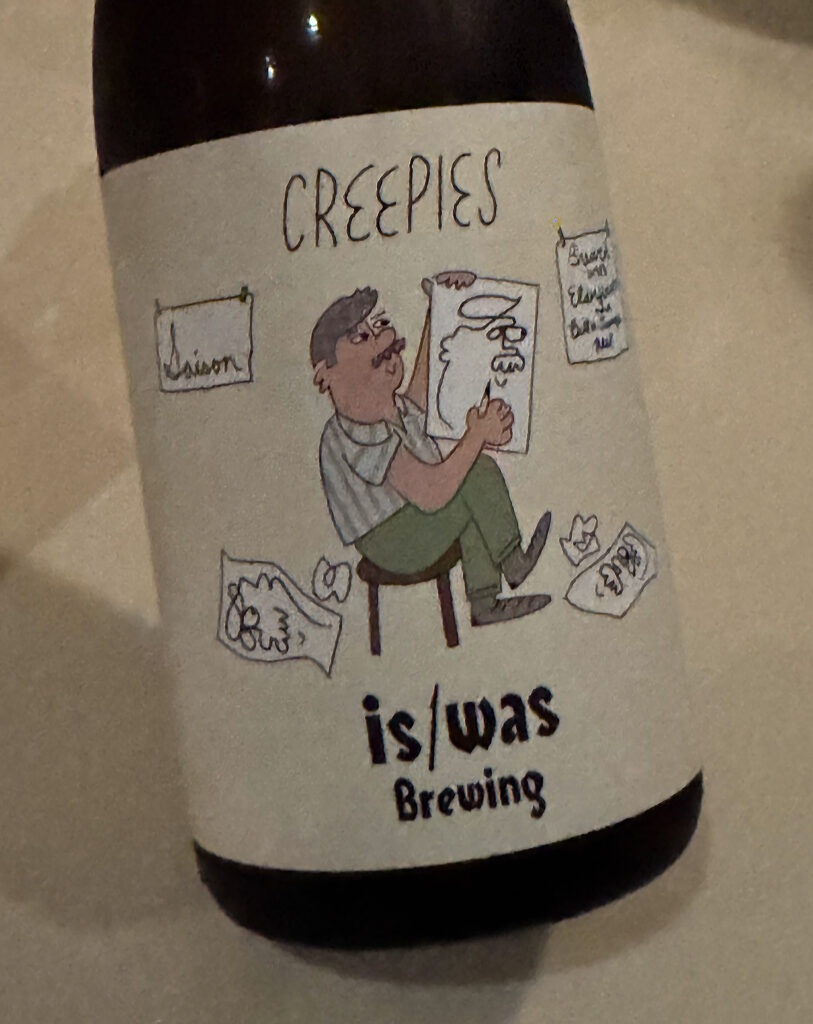
Other non-alcoholic options, a trio of beers (including a crisp, fruity collaboration with Is/Was Brewing capable of pleasing the most jaded oenophile’s palate), and a range of house spirits (at $12 each) round out the front page of the menu. On the back, one finds an extended selection of apéritifs, liqueurs, and eaux de vie—an altogether different manner of imbibing surely, but one that resonates with Creepies’s French roots and late-night appeal.
Turning to wine, I cannot remember the last time I witnessed a restaurant where so many parties have glasses, bottles, or even their own corkage gracing the table. I don’t think that’s necessarily in response to the cocktail program. No, I think mixed drinks that are streamlined and bracing (and quick to arrive!) naturally whet the appetite for something more sippable. Plus, the prospect of enjoying bistro food with a pour of a fun, frivolous variety (sometimes termed a “bistro wine”) is hard to resist.
Sher, in shaping the list, has focused predominantly on selections from California and France (with a bit of Oregon and Washington sprinkled in). As with her work at Cellar Door Provisions and Elske, the wine director privileges a natural approach to the craft. However, as always, she tempers any iconoclasm by embracing a wide range of producers—some handling familiar grapes in fairly familiar ways, others pursuing extreme expressions of terroir—that offers an entry point for drinkers of all stripes.
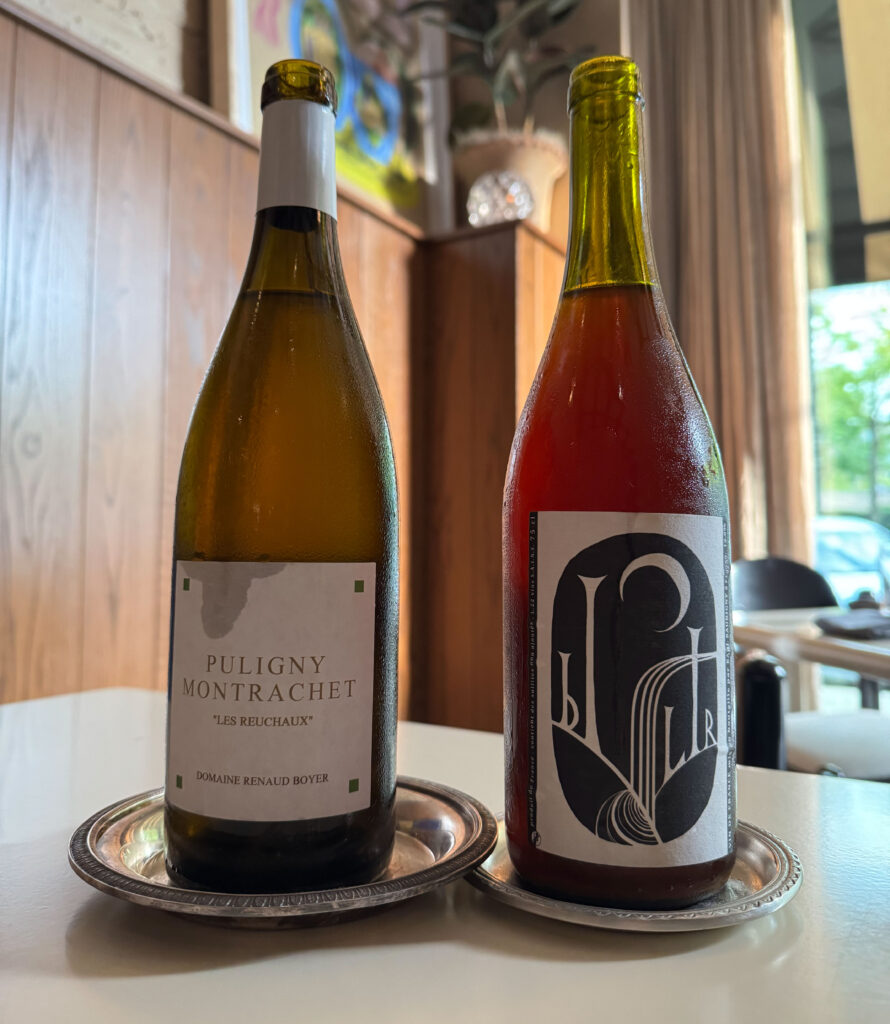
By the glass, Creepies has looked to names like Etteilla, Les Lunes, Populis, and Slow Dance, and to provide a baseline: contemporary Californian expressions of varieties like Sauvignon Blanc, Chardonnay, Pinot Noir, Grenache, and Zinfandel (sometimes blended with other friends) that offer an easy touchstone for diners who know what they want. Priced at $14 to $17 (with carafes also available for a little more), these pours help ensure that nobody—even if they do not recognize a single name on the menu—leaves unhappy.
But things quickly get a bit more interesting for those who are game: like a sparkling Pineau d’Aunis from Mosse ($18), a Jacquère-Altesse blend from the Savoie ($17), Muscat d’Alsace from Bruno Schueller ($18), and expressions of Chenin Blanc ($16), Gamay ($16), and Cabernet Franc ($15) all from the Loire.
Those willing to embrace the full depth and weirdness of the offerings will find things like a sparkling blend of apples and Syrah ($15), a skin-contact Cortese ($17), a macerated Pinot Gris ($16), a rosé of Tempranillo ($17), and a multivintage blend of Côt ($16).
Ultimately, only customers who insist on a glass of Champagne (or a close substitution) may come away from the BTG list feeling disappointed. But, even at concepts charging more for pours (and bending less to a natural philosophy), stocking an example of any quality or value remains a challenge. With that in mind, I think the options presented balance approachability and distinctiveness quite well. They’ve also evolved a good degree since opening, signaling a program that promises new excitement with each visit.
Of course, the bottle list is what really catches my eye. Here are some representative selections:
- 2023 Ashanta “Calypso” Chardonnay ($60 on the list, $36 direct from winery)
- 2023 Piquenique “Island Plum” ($64 on the list, $30 direct from winery)
- 2022 Michel Guignier Beaujolais-Villages “La Bonne Pioche” ($65 on the list, $34.99 at national retail)
- NV Mai et Kenji Hodgson “Luchini” Blanc ($72 on the list, $35 at national retail)
- 2022 Jean-Pierre Robinot “Fêtembulles” ($72 on the list, $39 at national retail)
- 2019 Château La Closerie du Chêne Saint-Émilion “Christiana” ($82 on the list, $39 at national retail)
- 2023 Julien Altaber Bourgogne Rouge ($88 on the list, $40 at national retail)
- 2022 Alexandre Bain “Terre d’Obus” ($90 on the list, $50 at national retail)
- 2022 Benoit Rosenberger “Six Roses” ($90 on the list, $53 at national retail)
- 2022 Céline & Laurent Tripoz Mâcon-Loche “Cuvée de Clocher” ($90 on the list, $38 at national retail)
- 2022 Jérôme Saurigny “Biclir” ($98 on the list, $60 at national retail)
- NV Laherte Frères Champagne Blanc de Blancs ($120 on the list, $54.95 at local retail)
- 2020 Domaine de l’Octavin “Pamina” ($120 on the list, $76 at national retail)
- 2022 Clos des Vignes du Maynes Mâcon “Cuvée 910” ($134 on the list, $67 at national retail)
- NV Domaine de l’Octavin “Corvée de Trou Trou” ($140 on the list, $77.99 at national retail)
- 2022 Domaine les Fauvettes “De l’Aube à l’Aube” ($150 on the list, $84 at national retail)
- NV Olivier Horiot Champagne “Métisse” ($150 on the list, $65 at national retail)
- NV Maison Valette Mâcon-Villages [1.5L] [$200 on the list, $122 at international retail)
- 2022 Renaud Boyer Puligny-Montrachet “Les Reuchaux” ($220 on the list, $115 at national retail)
- 2022 Patrick Desplats “Brahma” ($233 on the list, $114 at international retail)
At first glance, the chosen wines do a great job of satisfying guests whose tastes might lean more traditional. Yes, by paying a little more of a premium, these drinkers can secure themselves a bottle of Champagne (Laherte, Horiot), white Burgundy (Tripoz, Valette, Boyer), red Burgundy (Altaber, Guillot, Fauvettes), or even Bordeaux (Closerie du Chêne).
In truth, these are somewhat atypical examples of their respective regions. However, they retain enough of the essential character one might expect while also paying respect to the wider philosophy that shapes the list—favoring expressive fruit, complicating hints of oxidation, and an absence of tannins that enables early drinking.
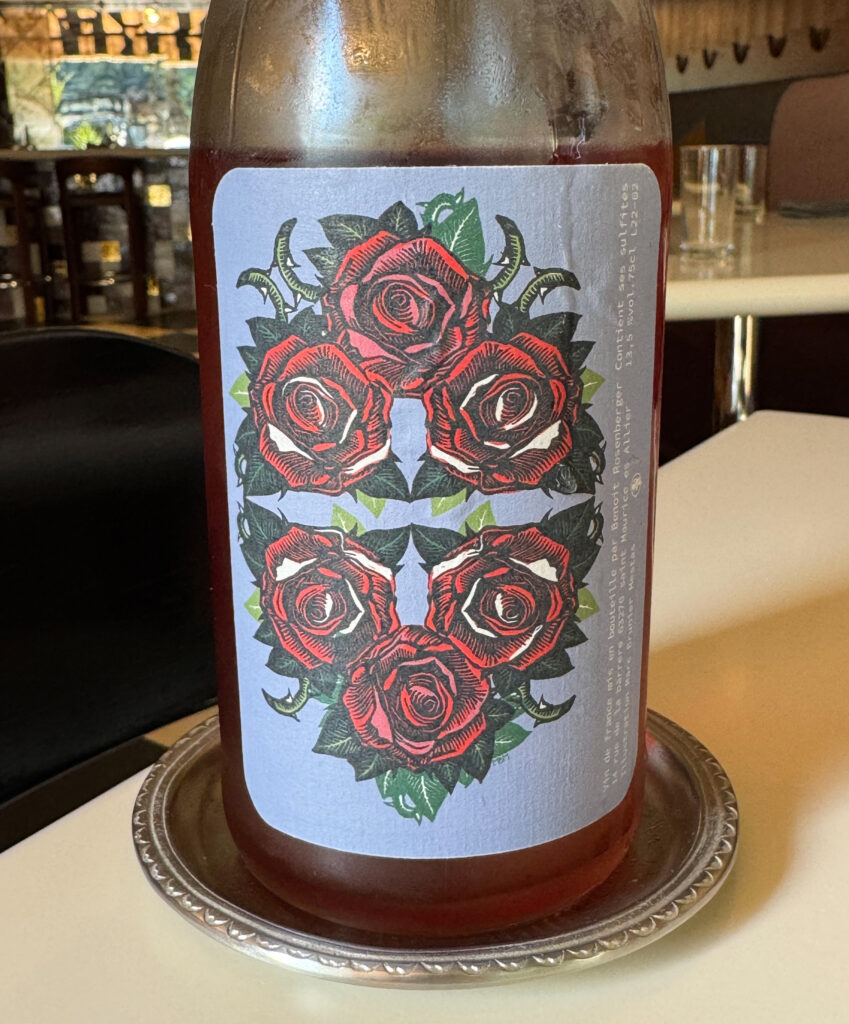
Diving deeper, one finds oddballs (like the “Island Plum” sparkling wine made from Italian plums and apples). There are also plenty of options in the $50 to $70 range (granting diners additional choices at a price point that accords with what’s being sold by the glass). However, more than anything, my eye is drawn to names like l’Octavin and Robinot (alongside slightly more obscure producers like Mai et Kenji Hodgson, Benoit Rosenberger, Jérôme Saurigny, and Patrick Desplats too).
These are the kind of culty bottles that lovers of natural wine drool over, and Sher sprinkles them into the list (at no special markup) to reward those who recognize and appreciate the estates’ work. These selections rank among the most expensive offered, and it seems as though Creepies, rather intentionally, wants to maintain a list that is shorter and more affordable than what can be found at Elske. Thus, it is only when one of these hallowed names sells out that another is chosen to take its place: a system that encourages patrons to grab what they can when they can and come back promptly to see what other rarity is stocked next.
Few lists in Chicago tap into this kind of palpable excitement: a sense of discovery and value that compels repeat patronage for the mere sake of trying something one would otherwise never taste. I’ve long felt that way at Elske (with regard to the wines of Bruyère & Houillon, Maison Maenad, and Houillon-Overnoy that occasionally pop up), so it’s especially nice to see that same spirit preserved here.
When one looks at how generously the bottles at Creepies are priced, the picture grows even rosier. For this sample, markups range from as high as 137% to as low as 58% on top of retail price. However, considering the mean value of 93% and the median of 89%, it is safe to say that the restaurant is charging about as low a premium as one will find in this city (no less for esoteric producers that resist any easy point of comparison between venues).
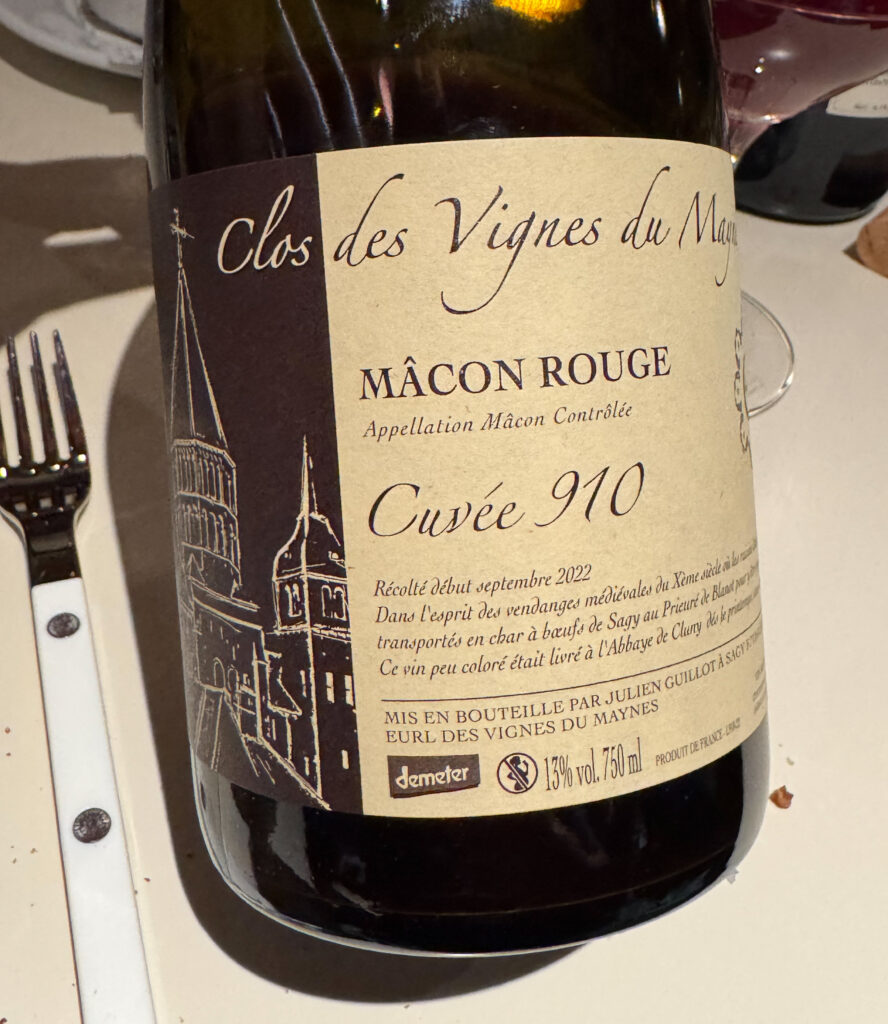
Overall, I think Sher has shaped a wine program that, at launch, has already earned a place among Chicago’s most forward-thinking lists. Her willingness to continually bring in small parcels of product—ones that may only last a couple of weeks—leads me to believe that the selection, however short, will always remain sweet. And, while I can certainly argue that the preference for natural wines (albeit at a sub-$100 price point where they really outperform conventional bottles) will turn some proportion of customers off, Creepies is not as iconoclastic as Cellar Door Provisions.
Corkage (for, assumedly, the same $35 fee charged at Elske) is allowed, and I was happy to meet a younger couple drinking a 1990s Haut-Brion at the table next to mine on one occasion.
Other patrons will be forced to tangle with something a little funky and unfamiliar. Yet this is the kind of natural wine evangelization—appended to a trendy, approachable restaurant (and according fully with France’s own neo-bistros)—Chicago desperately needs.
From front to back, Casillas-Rios and Sher have built a beverage selection that belies Creepies intimate size. Yes, on some level, the pair’s work has clearly been attuned to the space and pace of this neighborhood spot. But it lacks none of the depth or discriminating taste they have shown at Elske. In fact, with less choice paralysis to deal with, consumers may find the assembled drinks strike with even more pleasure: yielding a carefree, sneakily complex kind of thrill that outmaneuvers bloated concepts touting greater resources but no corresponding voice or vision.
Turning, at last, to the food, I will present the 19 dishes (out of 23) I tasted during my third visit to Creepies and further contextualize them in accordance with the 12 dishes (almost all of them repeats) I sampled when making my fourth visit. By combining these two sets of observations, I hope to offer criticism that pays respect to how much several recipes have already changed for the better.
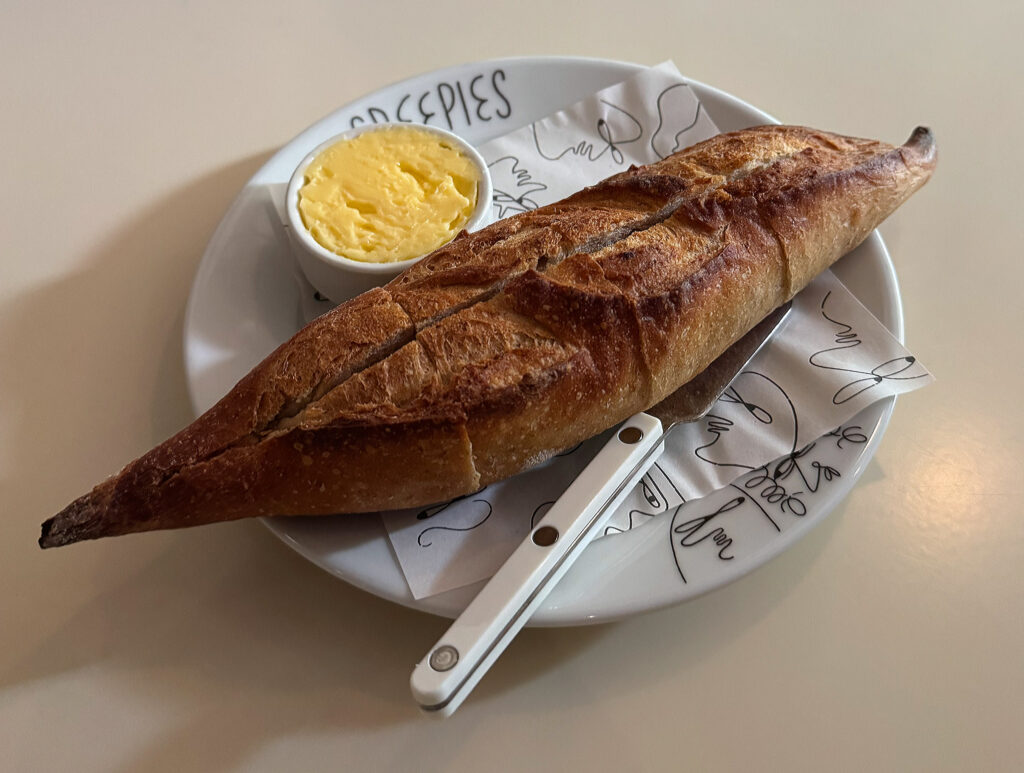
To begin, a serving of “Bread & Butter” ($8) seems like a sure thing—Elske’s “Oat Porridge Sourdough” has long been a must order after all. However, while the latter is proudly sourced from PQB, the former appears to be baked in-house.
Visually, this demi-baguette styled loaf looks the part: displaying attractive exterior scoring, golden-brown edges, and stiff points that are nearly capable of drawing blood. On the palate, the ends of the bread provide a hearty crunch with an acceptable fluffiness. However, the middle segments lack the same crispness and veer more toward density and dryness. (A later example would be crisper but with a similarly uninspiring crumb.) Thankfully, the butter—arriving beautifully tempered and offering a salty, subtly cheesy character—helps to improve one’s perception of the weakest pieces. But, at the end of the day, this is a merely good example of a recipe that should form one of the restaurant’s knockout staples.
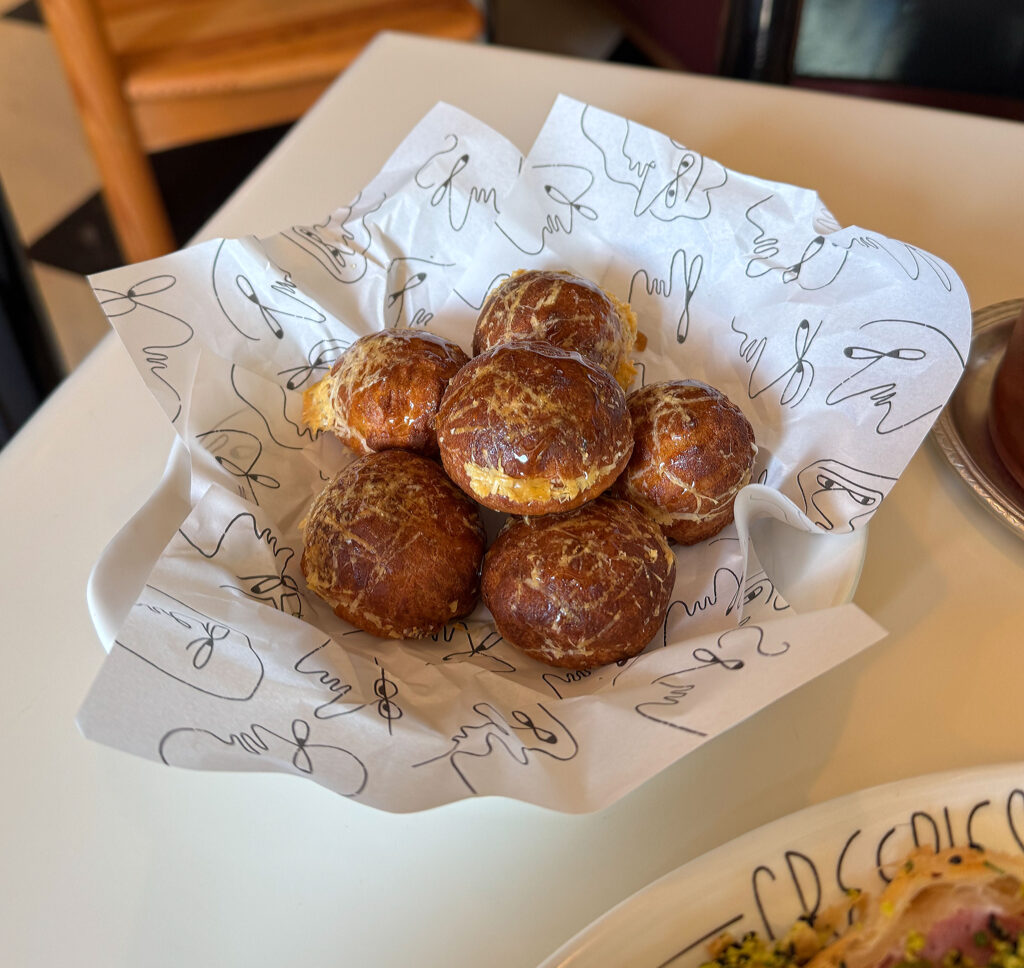
The “Warm Brie Gougères” ($14) might offer an easy solution for those who find the baguette to be a little boring. This baked pastry form, arriving six to an order, has probably displayed the most cosmetic variation across my visits. At opening, the exterior was dark brown, compact, and crowned with a layer of melted Gruyère moistened with honey. Later examples have excised the additional cheese and paired the gougères (now a lighter, more uneven tone of brown with noticeable splitting in their crust) with flaky salt. I’ve also noticed some temperature variation, as what should arrive hot and oozing can sometimes tend toward a warmer, denser mouthfeel.
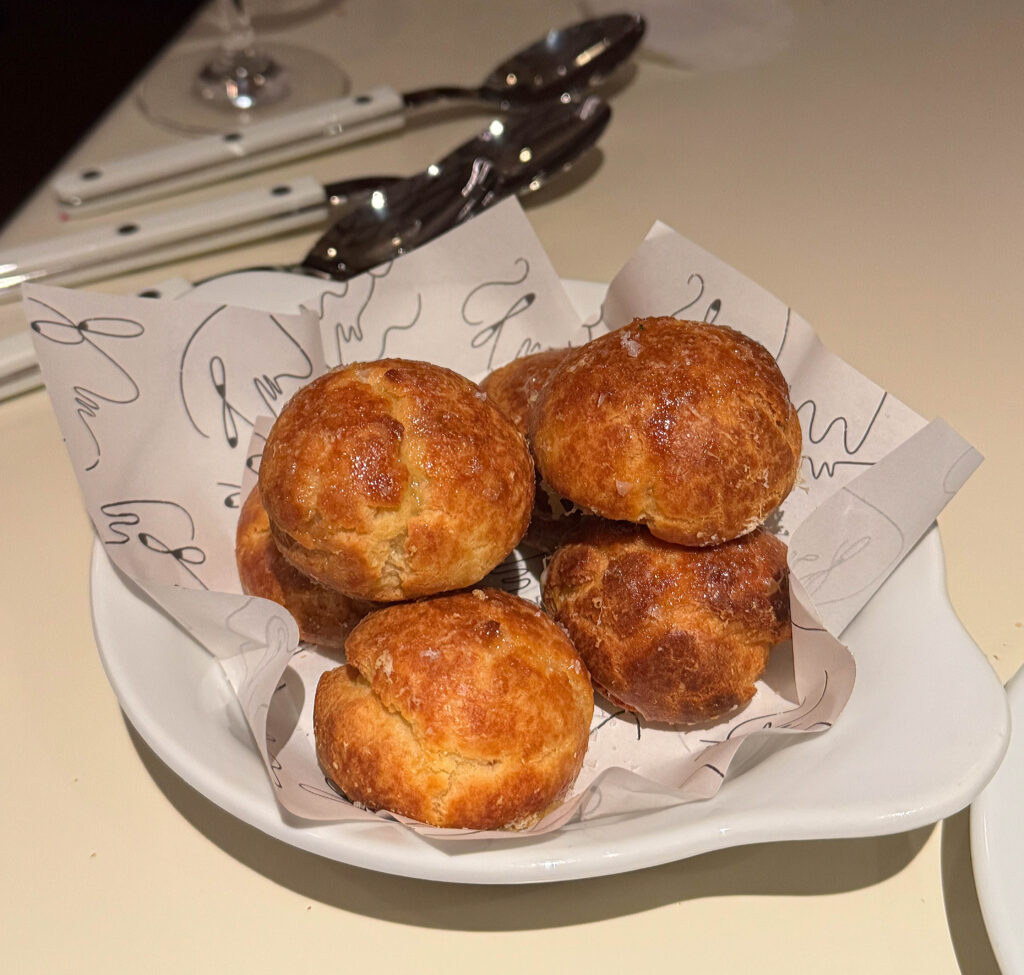
At their best, these bites combine a puffed, crumbly dough with a rich core of cheese that reveals itself with further chewing. Despite the presence of the honey, the Brie takes the lead here with a persistent earthiness (almost funkiness) that prevents the recipe from falling into dessert territory. Buoyed by that essential sprinkling of salt, this is a great expression of the ingredient in a crowd-pleasing form. Nonetheless, both the texture and flavor of the earlier, Gruyère-topped version were superior. The dish, back then, felt more elegantly packaged, more layered, and more extreme in its expression of nuttiness and sweetness. I’ll still order this item without fail—as it still ranks among the best things on the menu—but I must also acknowledge the preparation is capable of delivering more.
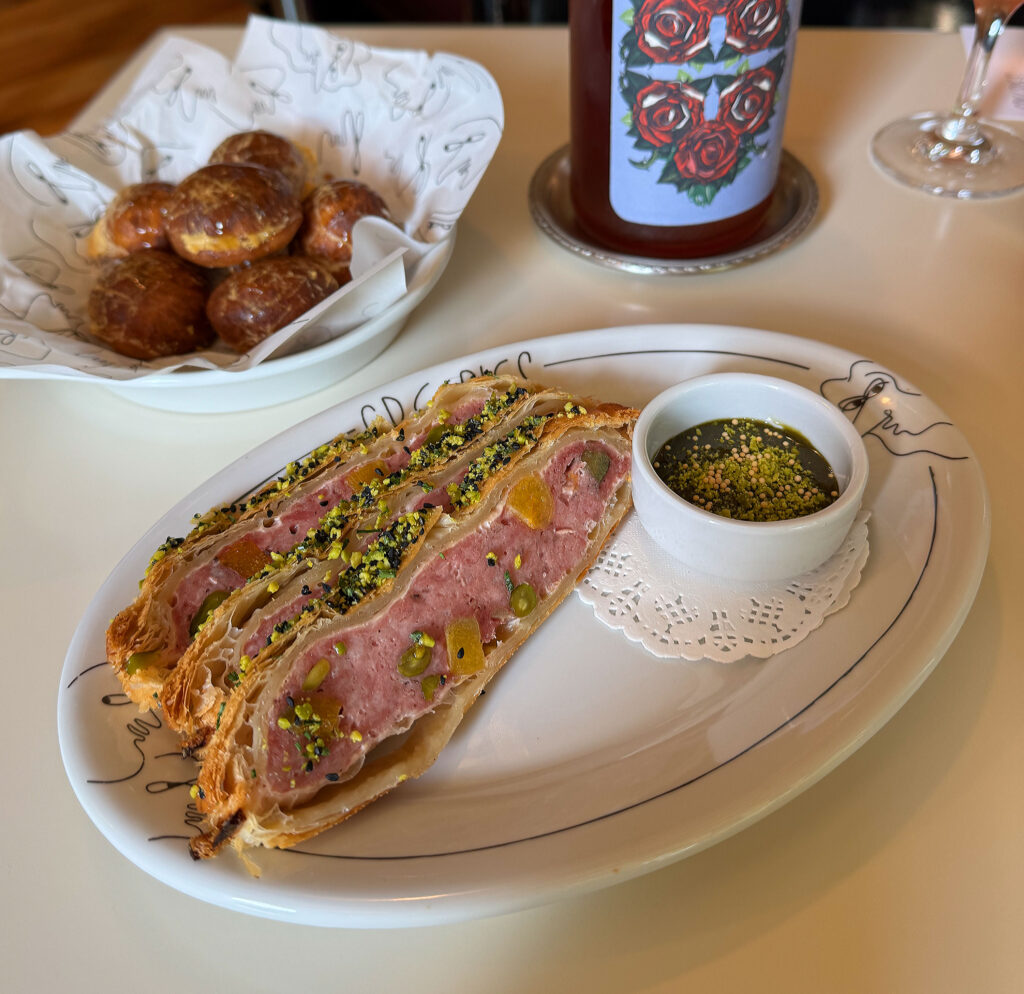
The “Saucisson with Puff Pastry & Pistachio” ($14) tells a similar story: being one of the things I ordered on opening night that has never exactly attained the same level of quality it achieved back then.
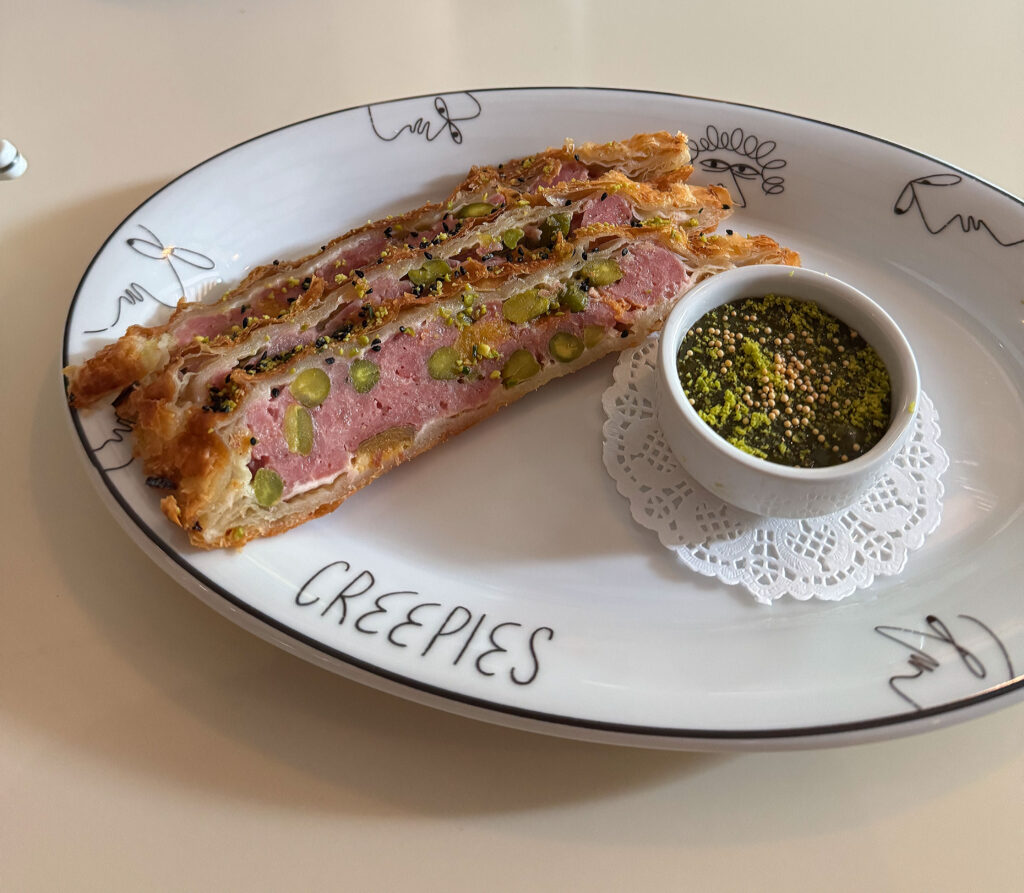
Let’s start with the good: the cured sausage here—so generously studded with the titular green nut—is wonderfully rendered. On the palate, it delivers plump, finely-grained meat that feels surprisingly moist and smacks of savory depth. An accompanying sauce, tinged with mustard and crispy bits, counters each bite with tang and sweetness. However, while the pastry wrapper displayed an attractive weight and flakiness on my first encounter, each subsequent example has seen it come out rather soggy and, worse, actually falling apart on the plate. (I think the difference can even be seen in my pictures.) Given how good the other elements on the plate are, this is a vexing flaw to be faced with. For, with just a little more refinement, the “Saucisson” should stand among Creepies’s signature dishes.
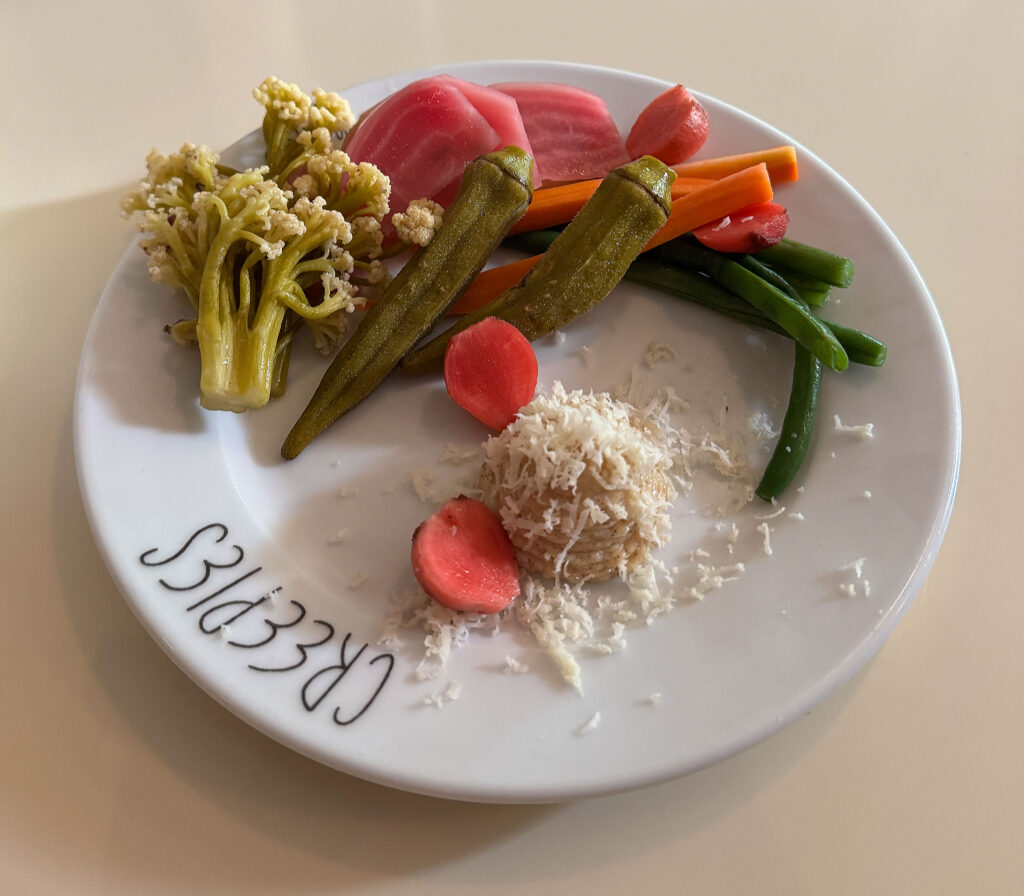
Closing out the opening snacks, a preparation of “Crudités with Horseradish & Brown Butter” ($10) is hardly the kind of item I would opt for. In fact, it’s exactly the kind of dish I would sacrifice in order to try one more plate from the substantial, most savory side of the menu. But, in truth, I have to admit that the recipe has grown on me.
The assortment of ingredients like baby corn, baby cauliflower, beets, carrots, fennel, green beans, okra, and radishes that arrives (most of them pickled, but one or two sometimes served raw) feels generous. And they each speak to the kitchen’s mastery of snappy textures and well-judged sourness. It’s a treat to pop these vegetables into one’s mouth at this early stage of the meal (opposite, say, the “House Vesper” or an acid-forward natural wine). The creamy dollop of brown butter adds a trace of richness, and I appreciate that its serving size has grown larger from visit to visit. Nonetheless, the resulting flavor here (which I expect to be decadently nutty) falls flat, and I get no pleasing pungency from the horseradish either. Ultimately, this is another recipe where the hardest work has already been done but a little tweaking remains necessary to actually help those starring elements sing.
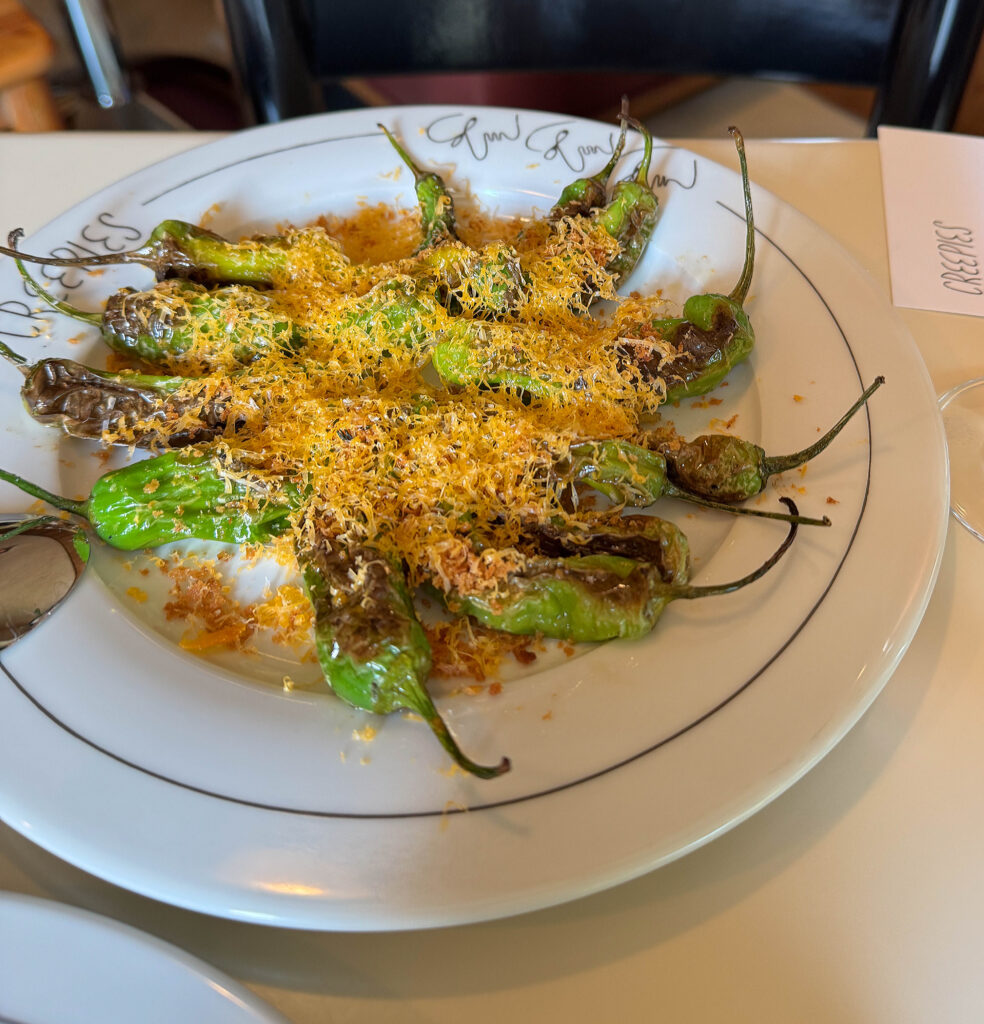
Kicking off the small plate section of the menu, a plate of “Shishito Peppers with Breadcrumbs & Mimolette” ($14) epitomizes how the Creepies kitchen is empowered to cast a wide net with the inspiration and ingredient sourcing for their dishes while still elegantly applying “French bistro” touches. On this occasion, three simple elements combine to put a spin on a popular, poppable Japanese appetizer.
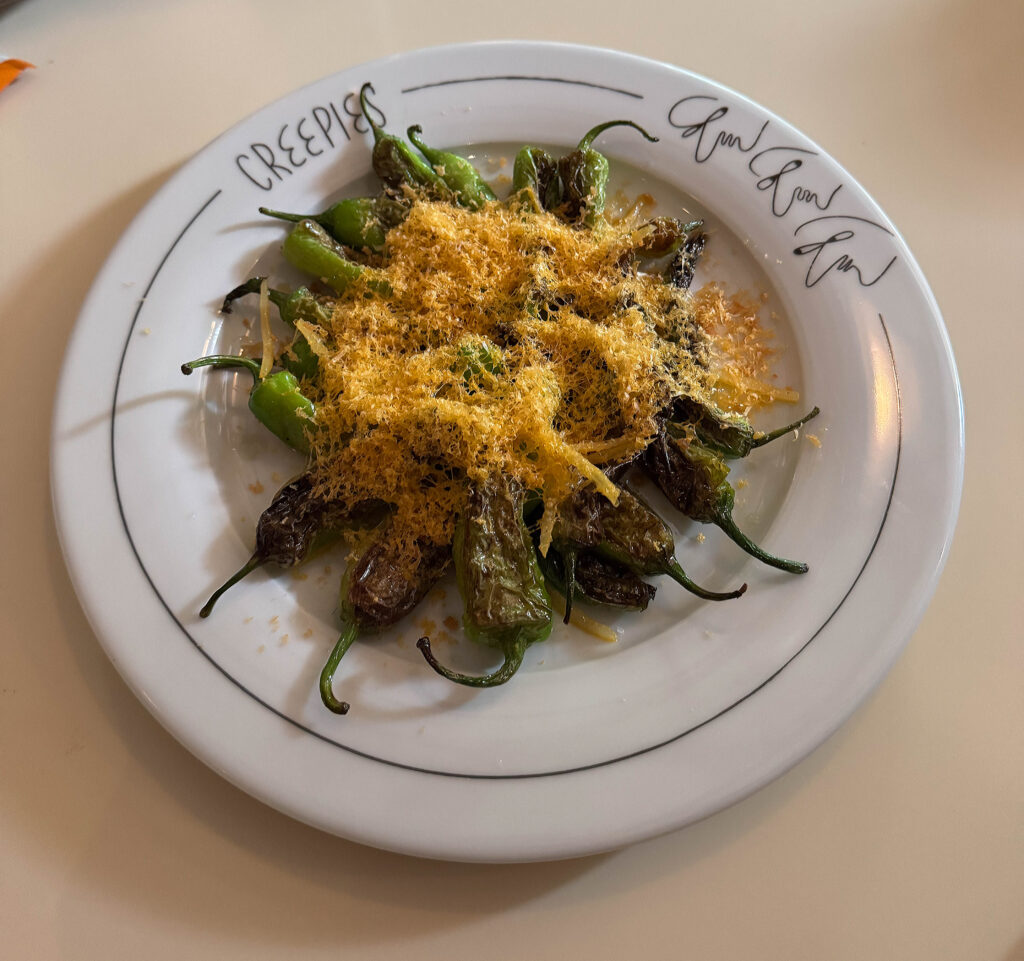
Each order comes with a little more than a dozen of the peppers, which arrive all curled and blistered under a lattice made from the orange-colored cheese. Texturally, the shishitos themselves are snappy and plump, displaying subtle notes of sweetness, smoke, and invigorating acidity alongside a higher incidence of heat that I am used to finding. (Really, it seems like one in four bites—rather than the one in ten conventionally cited—possesses elevated Scoville units. That’s not necessarily a bad thing.)
However, grated atop this foundation, the Mimolette is subject to the same variation that has blemished other recipes (observe the difference between the first and second pictures). Earlier in the restaurant’s life, the cheese arrived totally melted and reaching toward the end of the plate. More recently, it has been pooled toward the middle—unmelted, and thus incapable of effectively bonding to the peppers. This robs the shishitos of the gooey, nutty, and sweet character that is meant to distinguish the preparation. It also prevents the breadcrumbs from sticking to their surface and offering the desired, contrasting crunch. Overall, it’s not hard to see the winning idea at the heart of this dish, but inconsistency in execution has held it back.
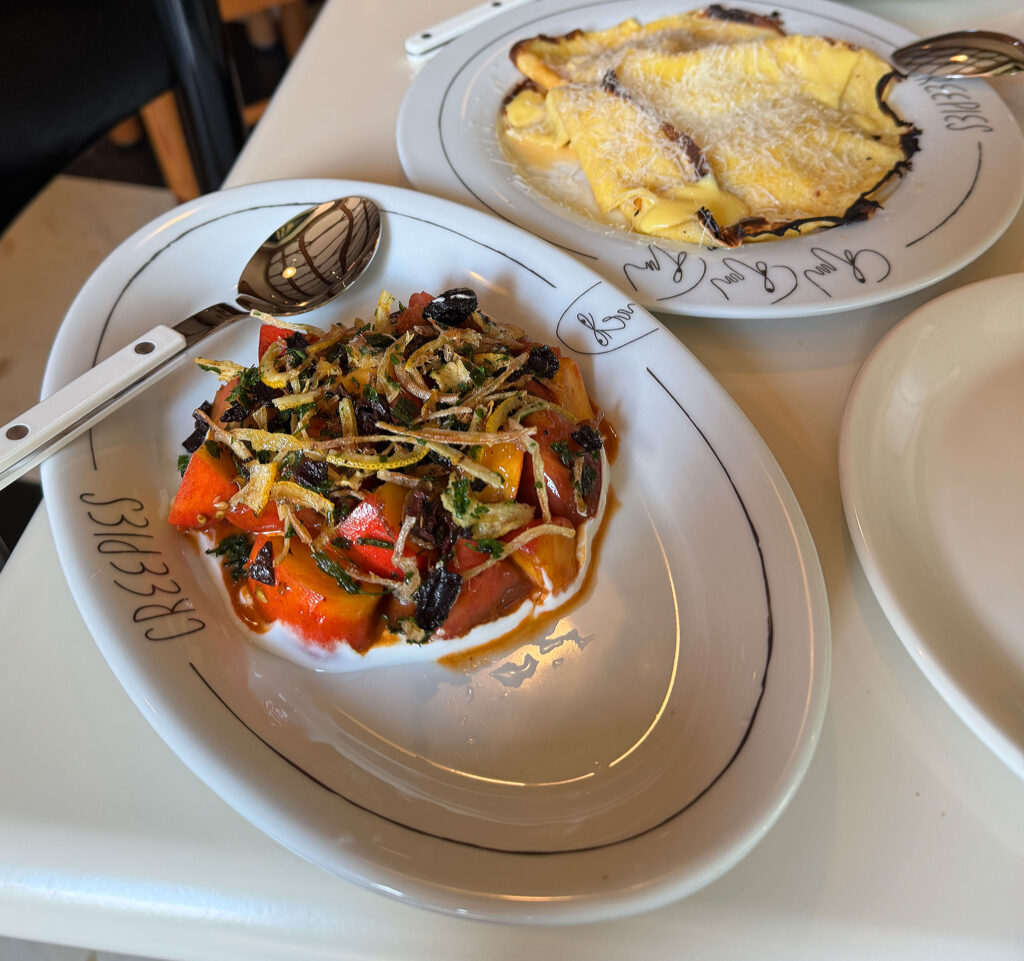
The “Tomatoes & Peaches with Crispy Tapenade & Labneh” ($18) might just represent the low point of the menu. At core, there’s wrong about combining chunks of the titular produce with thickened, tangy yogurt and a nest of crumbly olives, garlic, and herbs. Indeed, the juicy tomatoes—all creamily coated—are attractively rendered.
However, the tapenade topping, while brittle at first bite, strikes me as stale and woody (rather than actually shattering) on the finish. Worse, the peaches tonight are dramatically underripe: being jarringly firm and tart and failing to offer any of the overarching sweetness that is meant to make this combination of ingredients work. While I could take one of these lapses in stride, having two elements of the dish falter made for a clear disappointment (one, in technical terms, I never expect at this level).
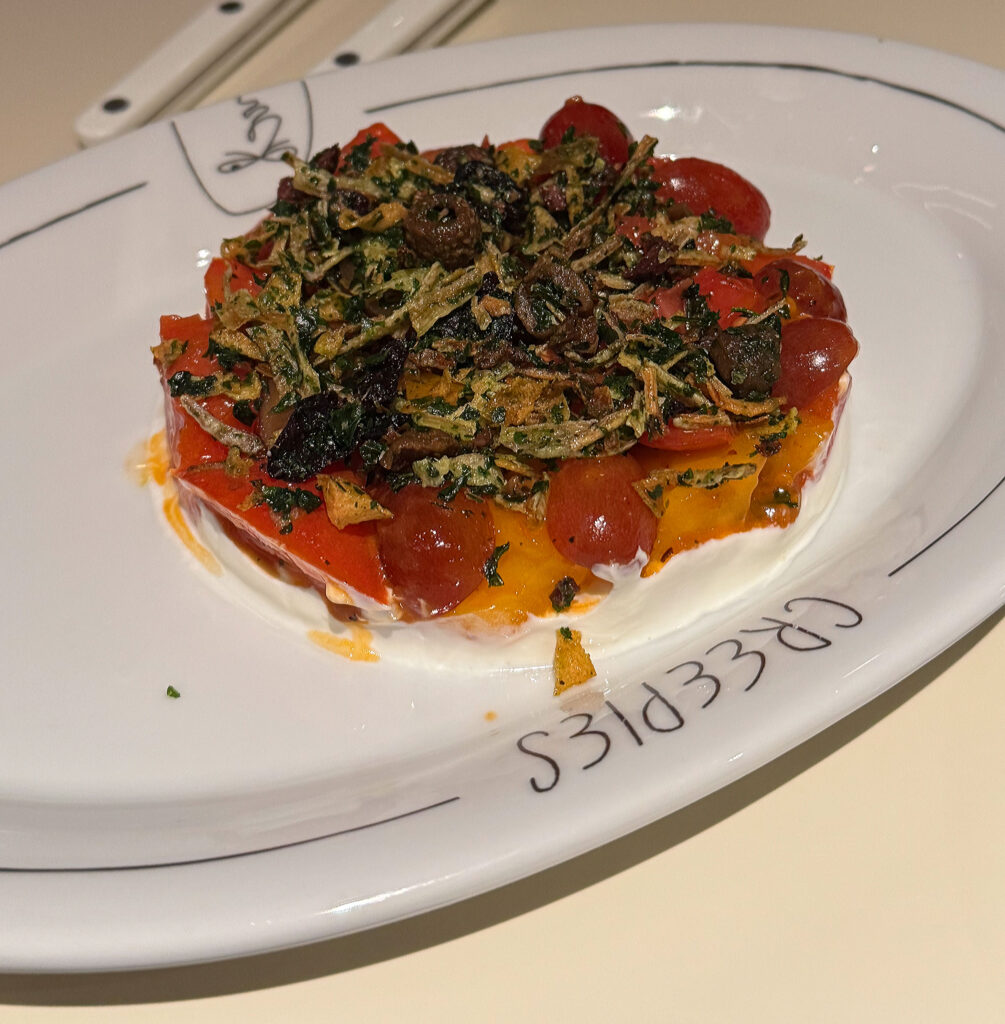
Thankfully, a subsequent preparation of “Tomatoes & Grapes with Crispy Tapenade & Labneh” ($18) has proven much more successful by simply freshening the texture of the crunchy topping and sourcing ripe fruit. The result is a layered recipe in which sweet, tangy, earthy, creamy, and shattering elements combine to form a uniquely decadent expression of seasonal produce. Indeed, this version of the dish—in fulfilling its potential—ranks among my favorites at the restaurant.
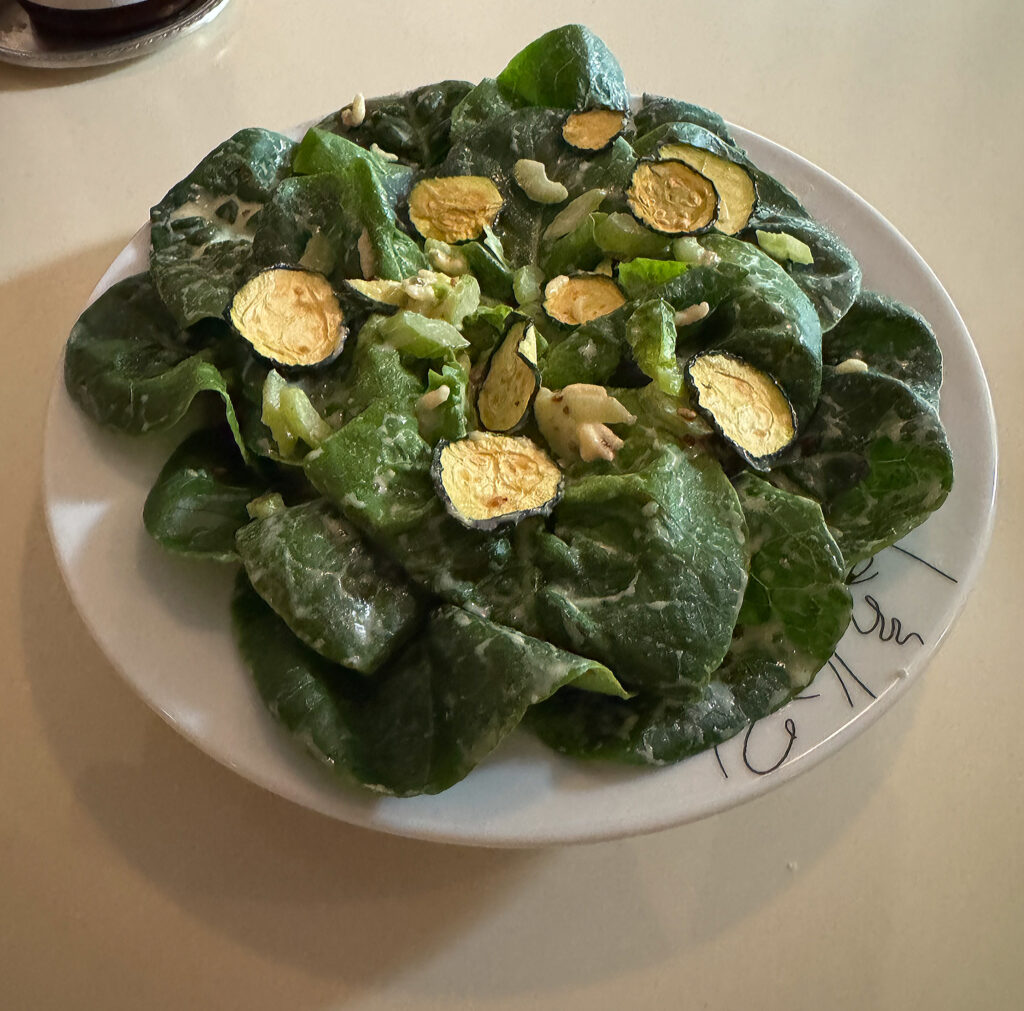
Creepies’s take on a salad—“Little Gem with Zucchini & Sunflower Seeds” ($14)—carries high expectations given the legendary status of the “Belgian Endive with Pickled Raisins, Creamed Sherry, and Walnuts” served at Elske. The idea here (at nearly half the price of the latter item) is far simpler: overflowing greens, a zucchini dressing, chips made from the same gourd, slices of celery, and the titular seeds.
On the palate, the leaves of little gem display only a trace of crunch. Nonetheless, they come creamily coated and serve as a vehicle for the earthy, vegetal dressing. Against this foundation, the watery snap of the celery pieces and more crumbly sunflower seeds provide most of the textural intrigue. Yet the zucchini chips, in a manner reminiscent of the preceding tapenade, feel stale. Ultimately, I really do not taste anything other than the celery here. However, the dressing in a later example showed a bit more sweetness, and newest iteration of the recipe (now incorporating apple) suggests the kitchen is on the right track.
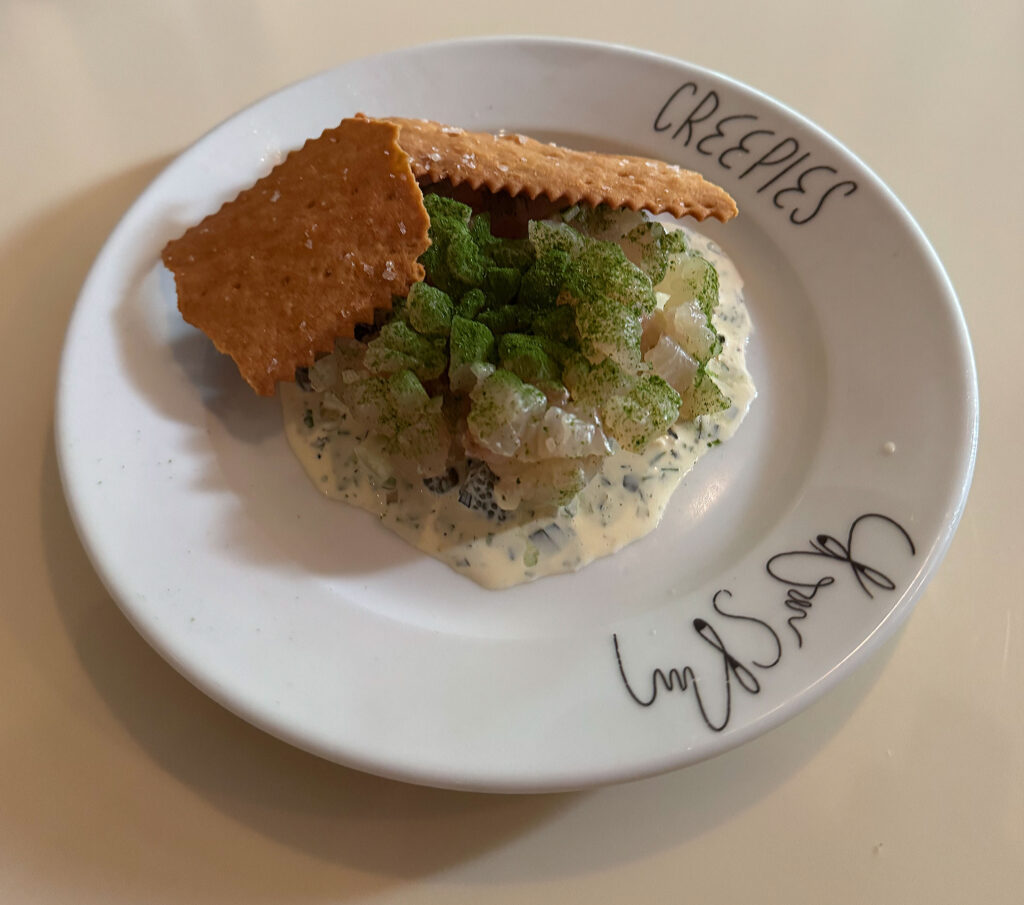
With the arrival of the “Fluke Tartare ‘Gribiche’” ($22), the meal starts to recover. This recipe centers on small chunks of the titular fish in an eggy dressing flavored with chervil, parsley, and tarragon that is studded with cornichons and capers. Though typically paired with cooked proteins, the sauce gribiche really flexes its muscles opposite the raw fluke, whose pleasing chew and sweetness is electrified by tang and anise.
For my palate, the tartare doesn’t really taste rich or savory enough at first blush (despite some underlying brininess) to get me excited. However, the incorporation of the accompanying buttery crackers—well-flecked with salt—delivers what I’m after: a textural cushion and accompanying roundness that serves to soften the preparation’s brighter notes. If anything, I’d like to see the restaurant provide a third one of these crackers to ensure that each bite of fish is accounted for. Otherwise, I think this is a tricky, intellectual dish that is being executed fairly well.
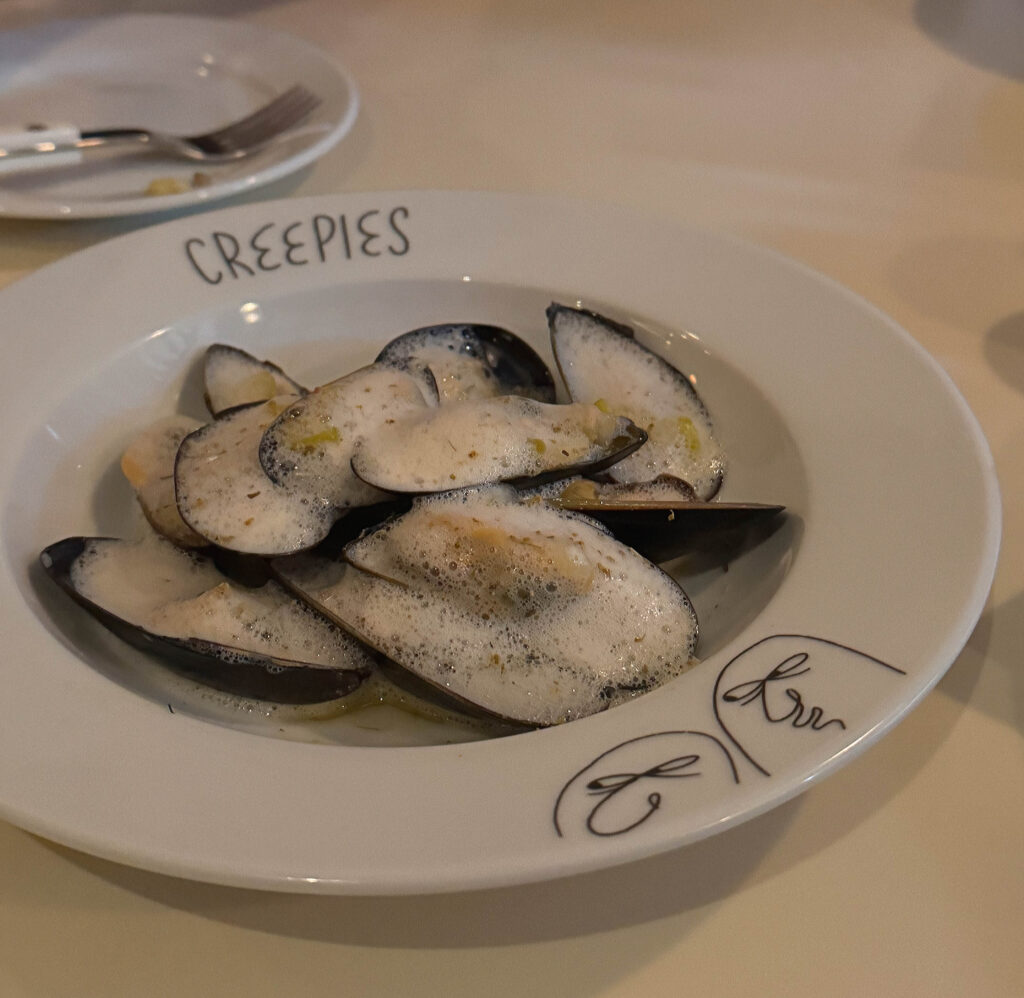
The “Steamed Mussels with Fennel Giardiniera & Pernod” ($24) has quickly established itself as one of the restaurant’s totemic offerings. After all, it so cleverly imbues one of the most archetypal bistro recipes with a bit of Chicago flair. The bowl—filled with shells that have been so lovingly cleaned, filled, and stacked—photographs quite well too.
On the palate, each bivalve leads with pristine, plump meat that is then punctuated by the brittle snap of celery or fennel. In turn, the Pernod-laced sauce here is rendered more as a foam—one that is siphoned directly into each piece in a manner that ensures easy, cohesive bites. The resulting anise-tinged flavor starts sweet (matching the latent character of the mussel) and ends on a surprising sourness. I’m not sure the giardiniera adds any perceptible heat to the equation, but there’s a lightness and purity here that I think matches natural wine far more than one might expect.
I personally prefer renditions of moules-frites that dive a little more strongly into savory notes of garlic, allium, and butter. However, I appreciate the fact that servers will proactively pair the side of “French Fries” one orders with this dish (helping to bolster satisfaction). I also cannot deny that the preparation is a crowd-pleaser: daring to play around with a beloved form and clearly succeeding.
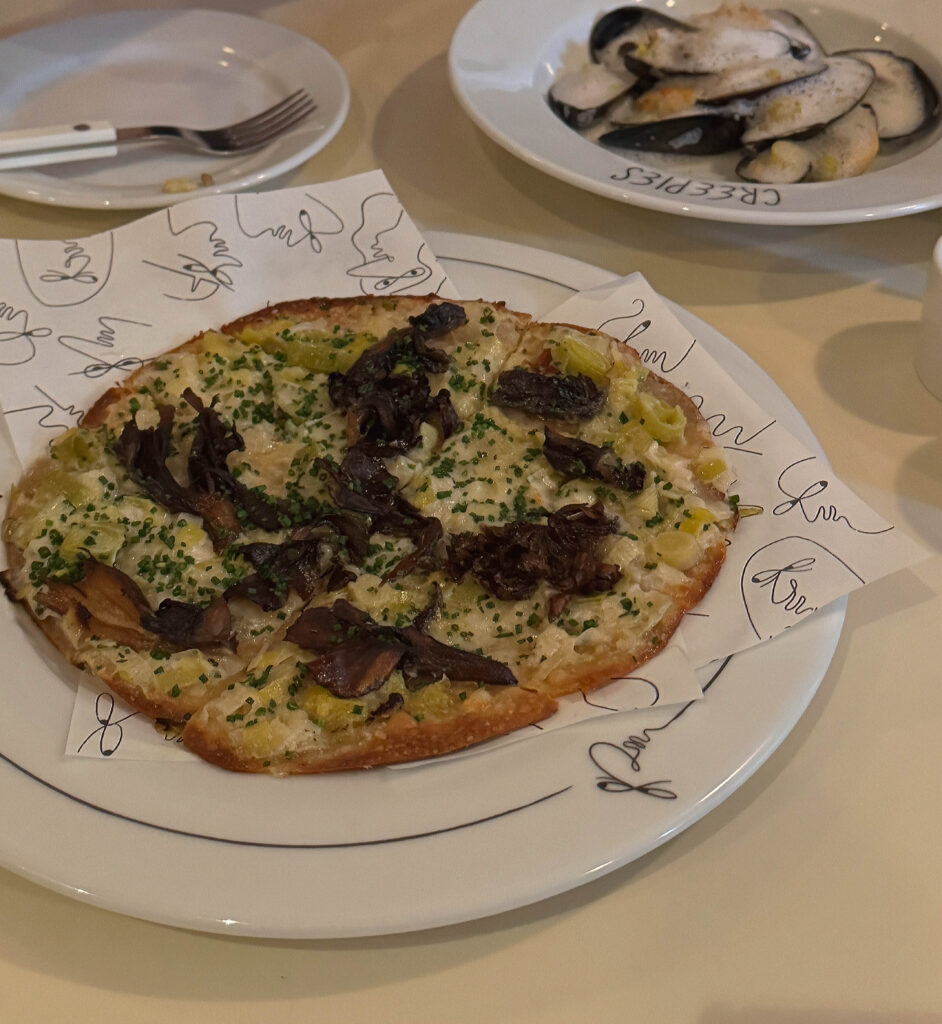
The ”Tarte Flambé, Tavern Style” ($14) is another instant signature: a wink at the type of pizza that has come to redefine what Chicagoans (and those from further afield) think of as the city’s defining form. Here, the consistency of the Alsatian flatbread (traditionally marked by a puffed fringe) is taken to a thin-crust extreme. It is loaded, correspondingly, with fromage blanc, onions, chives, and mushrooms (crispy maitakes to be exact) that evoke the traditional recipe.
Cut into a four-by-two grid, the tarteleads with an admirable cracker crunch. Nonetheless, it could be even crisper and could arrive at the table hotter. The same goes for the mushrooms, which are unevenly distributed and also perceptibly limper when compared to the crust. The flavor combination—of sweetness and earthy backed by tang and allium—is evergreen in is quality, yet I am left feeling like this novelty form (while appealing on the surface) isn’t being pushed to the level of true excellence.
Thankfully, on my fourth visit, the “Tarte Flambé” fulfills its potential: offering a pizzeria-caliber shattering crust, matched perfectly by the same quality from the maitakes, and (with everything arriving at a hotter, meltier temperature) a beautifully cohesive (now almost nutty) flavor that leaves one desperate for another bite. Though only “good” during the first few times I encountered it, this dish (assuming the execution stays at this level) has earned its place among the very best things Creepies serves.
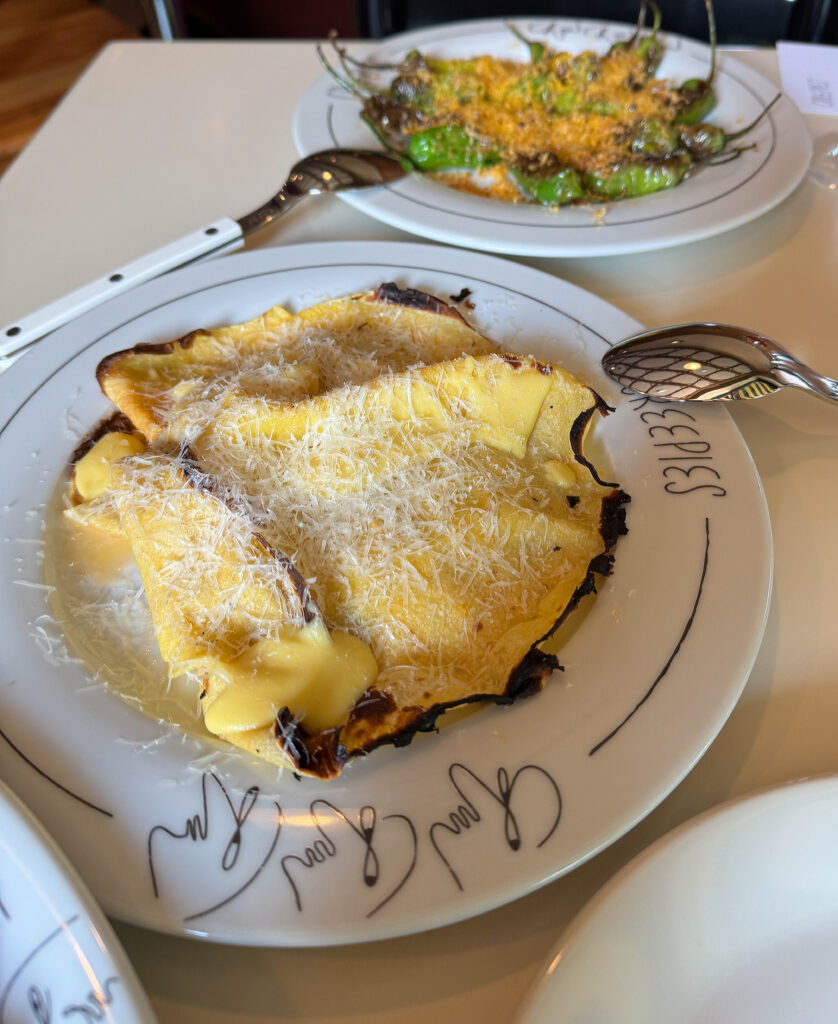
The ”Corn Crepe, Summer Succotash & Green Tomato” ($22) caught my attention from the first moment I laid eyes on the menu. What’s not to like about a traditional French form being bent toward flavors that feel so Midwestern? Like many preparations here, I can observe how the execution of this recipe—even at a visual level—has changed since opening. Namely, the crêpe has grown more misshapen, the sauce has been applied more liberally, and the cheese (what looks like shredded parmesan) has been applied less liberally.
Despite this variation, the dish has largely maintained its quality. To start, the crêpe itself is skillfully fashioned: boasting some wonderfully charred edges and coming apart cleanly when it meets one’s knife. These delicate folds deliver a foundational note of sweetness that enhances the bits of corn and red pepper that wait within the interior of the plate. Honestly, I have trouble placing the green tomato here (could its acid be incorporated in the sauce?). The cheese, for all the fuss, doesn’t strike me with any predominant salt or nuttiness. Rather, flavor here remains centered on corny sweetness and fruity pepper depth. At times, it almost comes across as a little too wet and loose and sickly. But I’ve generally found pleasure in this offering, and I am enthusiastic about the kitchen’s continued creative work with this form.
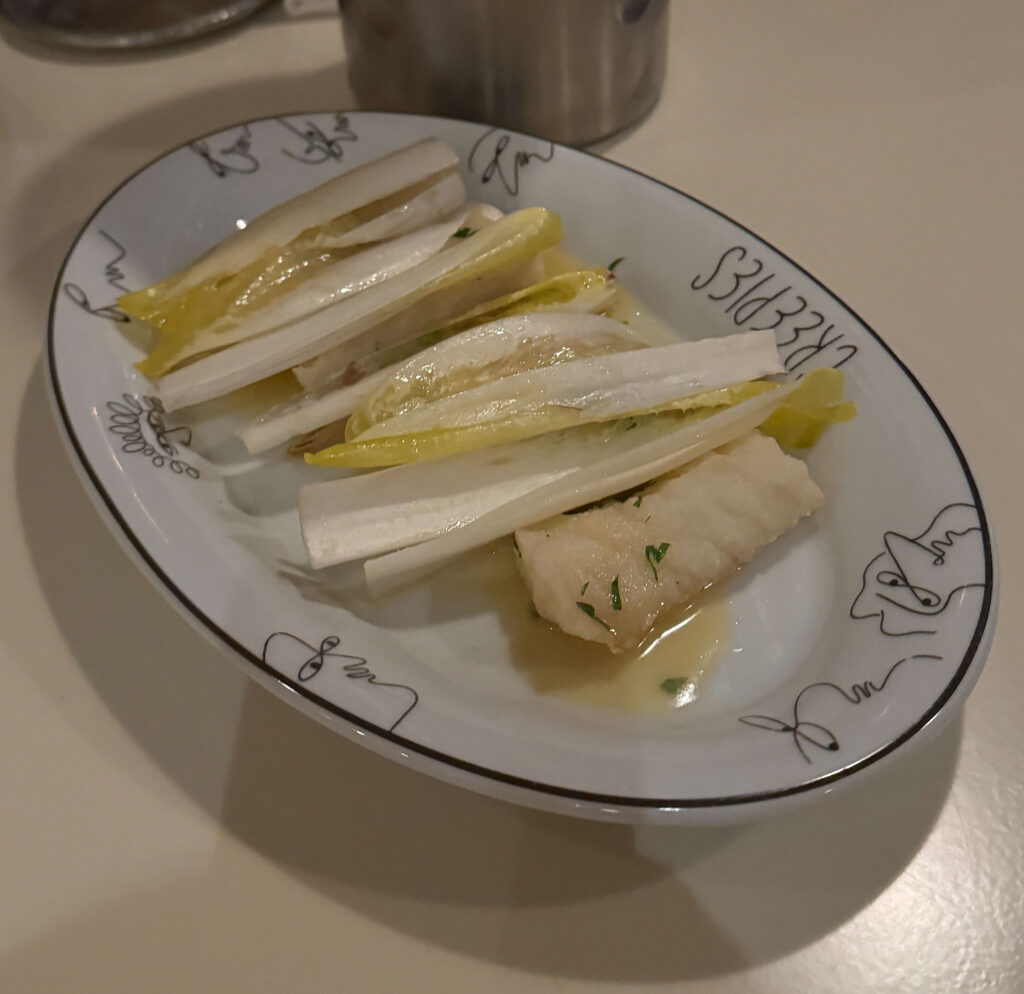
The “Cod Meunière with Endive” ($23) represents (a bit like the “Fluke Tartare ‘Gribiche’”) a bold foray in the realm of classic sauces with a bit of a twist. Substituting the glamorous sole for the chosen fish is not unheard of. Indeed, the floured, faintly crusted cod offers an appealing flakiness with a mild flavor marked by just enough salt. The accompanying notes of lemon and brown butter do their part to amplify the fillets’ pleasure.
However, it’s the endives (rendered via cooked leaves on the bottom and raw ones on top) that prove the most polarizing. While the former—sweet, nutty, with only traces of structure—make for a harmonious pairing with the fish, the latter do more to dominate the dish. They are cool and crunchy and decidedly bitter: making the dish eat more like a salad than its place on the menu would otherwise suggest. The raw endives’ lingering bitterness, through the finish, also effectively counteracts any decadence that the meunière sauce helps to build. Ultimately, I do not think the combination of the two leaves is necessarily unfounded, but the proportions of these two components need to be rethought.
A preparation of “Parisian Gnocchi with Gruyere, Ham, & Egg Yolk” ($22) forms the last of the small plates, and it’s a fun one: poached pieces of pâte à choux dressed like a croque-madame and crowned with a gossamer cracker. It’s the closest thing you’re going to get to a pasta in this genre, and (alongside items like the tarte and the crêpe) it speaks to the number of different techniques the kitchen here is willing to grapple with.
On the palate, the gnocchi themselves feel dense and creamy. Yet some of the accompanying ham bits are hard and burnt. And the cracker, too, displays the same kind of staleness (seen with the tapenade and zucchini chips) that prevents it from forming the brittle contrast that’s intended. When it comes to flavor (and perhaps due to the overcooking of the pork), the dish lacks salt. Thanks to the cheese and the egg yolk, it still feels rather rich. But, lacking the right balance to help all this weight actually yield satisfaction, the recipe comes across as plodding and even a bit unsettling. Who wants to eat what amounts to bland goop when there is so much else to get excited about here?
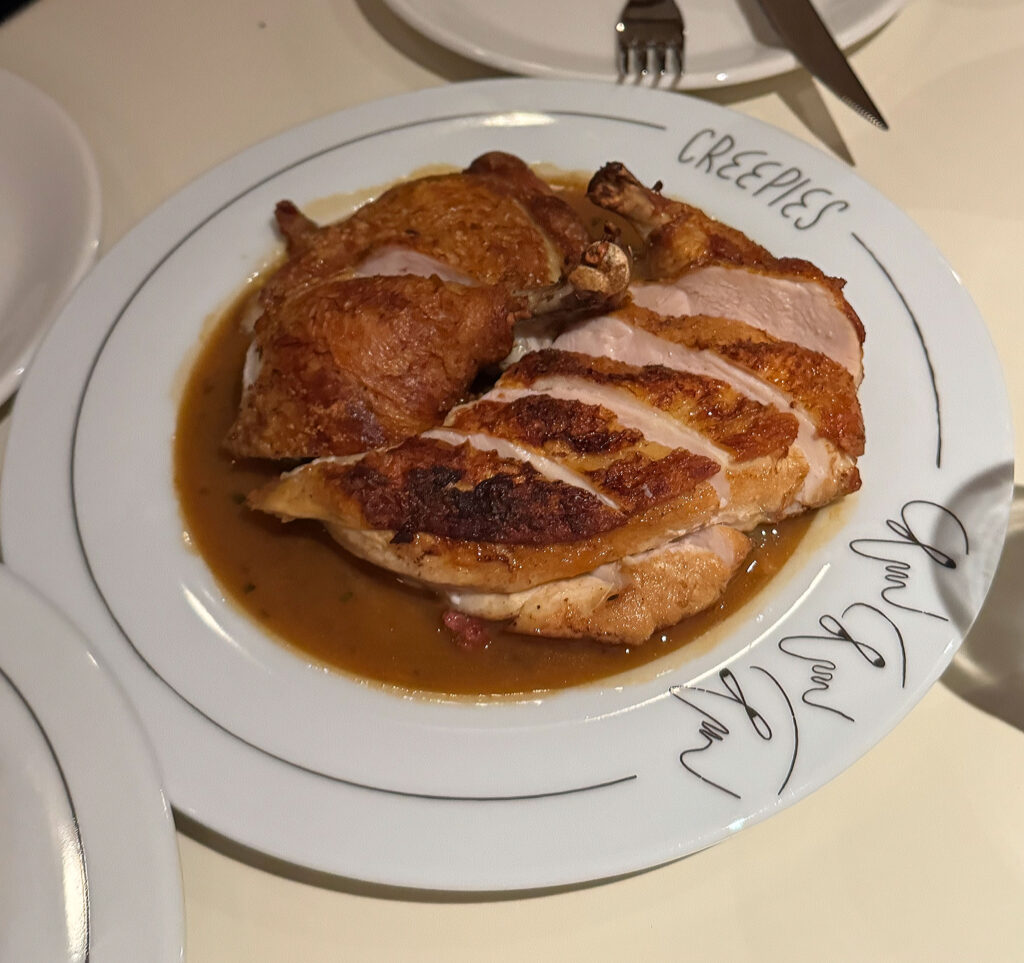
Coming now to the entrées, we start with a combination of “Roasted Chicken with Liver & Wine Sauce” ($39) and “French Fries” ($10) that David Posey considers (along with a salad) his “death row meal.” I’ve ordered this bird—which is “air-chilled,” “cured in salt and sugar, poached, dried overnight and then roasted to order”—twice now.
On the first occasion (when, admittedly, it was shared by a larger party), it made little impression: that is, it displayed no clear flaws but also didn’t leave me thinking the restaurant had done anything special with the form. Trying the dish again during my fourth, most recent visit, I felt it had made a real jump in quality. Visually, I note that this skin is now crisper, the pieces are fanned out more attractively, and the accompanying sauce possesses a darker hue.
Texturally, the chicken (and I am able to sample a bit of each portion this time) displays a remarkable moistness with just a hint of framing crust. The liver and white wine sauce—studded with pieces of offal—is savory, yes. But I also perceive a degree of brightness here, reminiscent of pho spices, that infuses the meat (so richly dressed) with added warmth and sweetness. The effect is subtle but absolutely spellbinding: adding unique, lip-smacking quality to the bird that lacks easy comparison (and, indeed, shines next to any other example in the city I can think of).
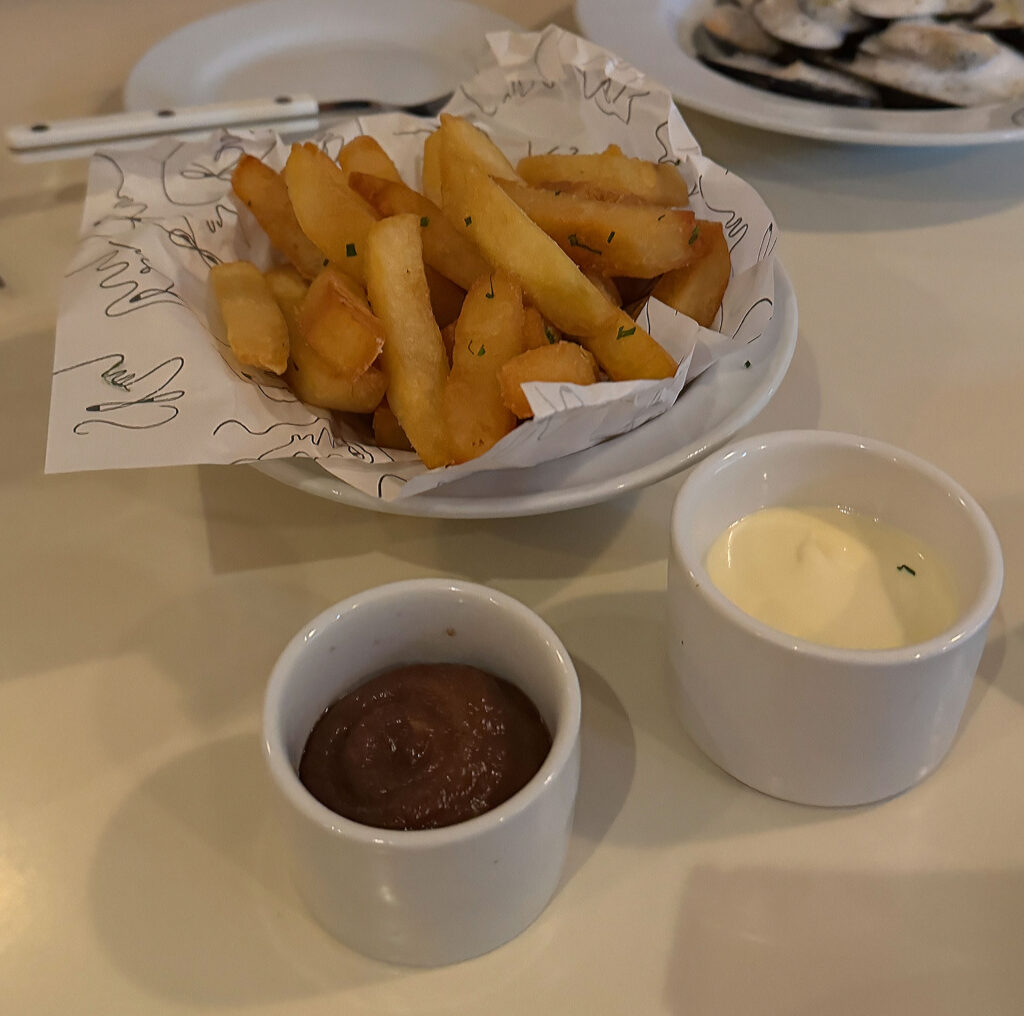
When one also considers the “French Fries”—themselves the product of a three-day process that ends with them being cooked in clarified butter—I must concede that this course is worthy of that “last meal” status. In fact, visit after visit and time after time, this side dish has never faltered. Remarkably crisp on the outside (almost as if they have a “shell” coating), the potatoes are thick enough to provide a perfectly fluffy contrast with each bite. They’re salted in a way that demands no condiment, but the accompanying garlic aioli—and even moreso the onion chutney (a maddeningly good substitute for ketchup)—only serves to heighten this offering’s appeal. Ultimately, I must join in the opinion that (barring certain hot dog stands) Creepies is making the best fries in Chicago.
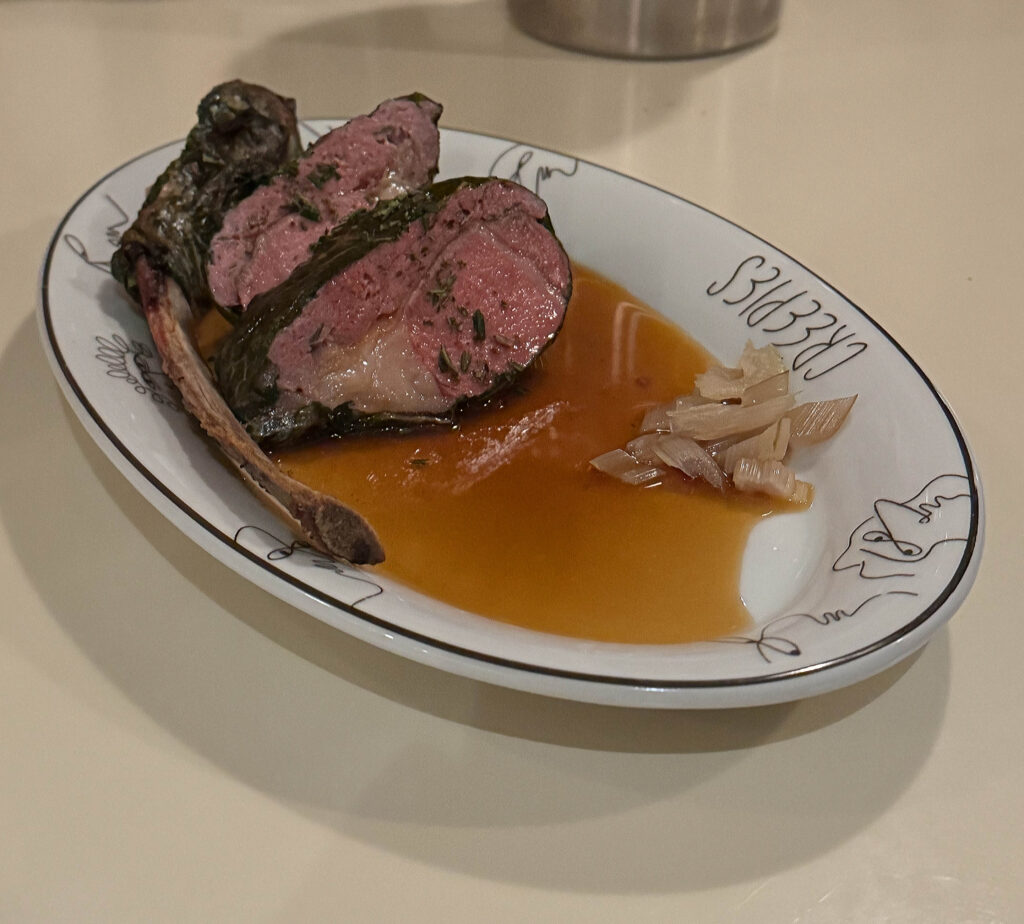
Seeing out the savory portion of the meal is a preparation of “Roasted Lamb with Swiss Chard & Herbes de Provence” ($45) paired with another side of potato: the “Pommes Ratatouille” ($10).
The main event arrives looking like an oversized chop. However, the lamb is actually prepared as a farce: with a sausage-like layer of the meat sitting atop a fat-capped strip of the original flesh (all wrapped in the titular chard). Two sizable portions (along with a bone to nibble on) arrive swimming in jus. Off to the side, a small pile of pickled celery forms the finishing touch.
On the palate, I find the interplay between the firmer forcemeat (displaying some of the same refinement as the earlier saucisson) and the yielding, juicy flesh from the rib to skillfully composed. The pocket of fat, likewise, is appropriately melty. Flavor here is fairly pristine: being free of that earthy, musky quality and more redolent of rosemary than anything. The celery, as a crisp and acidic counterpoint to the meat, also forms a welcome presence. However, like my early encounters with the roast chicken, I think this recipe still has more room to grow before it can be considered a “can’t-miss” closer. Yes, this item feels competently (but not memorably) conceived at the moment, and I’d like to see it push the tenderness and savory intensity of the starring ingredient to an even higher stratum.
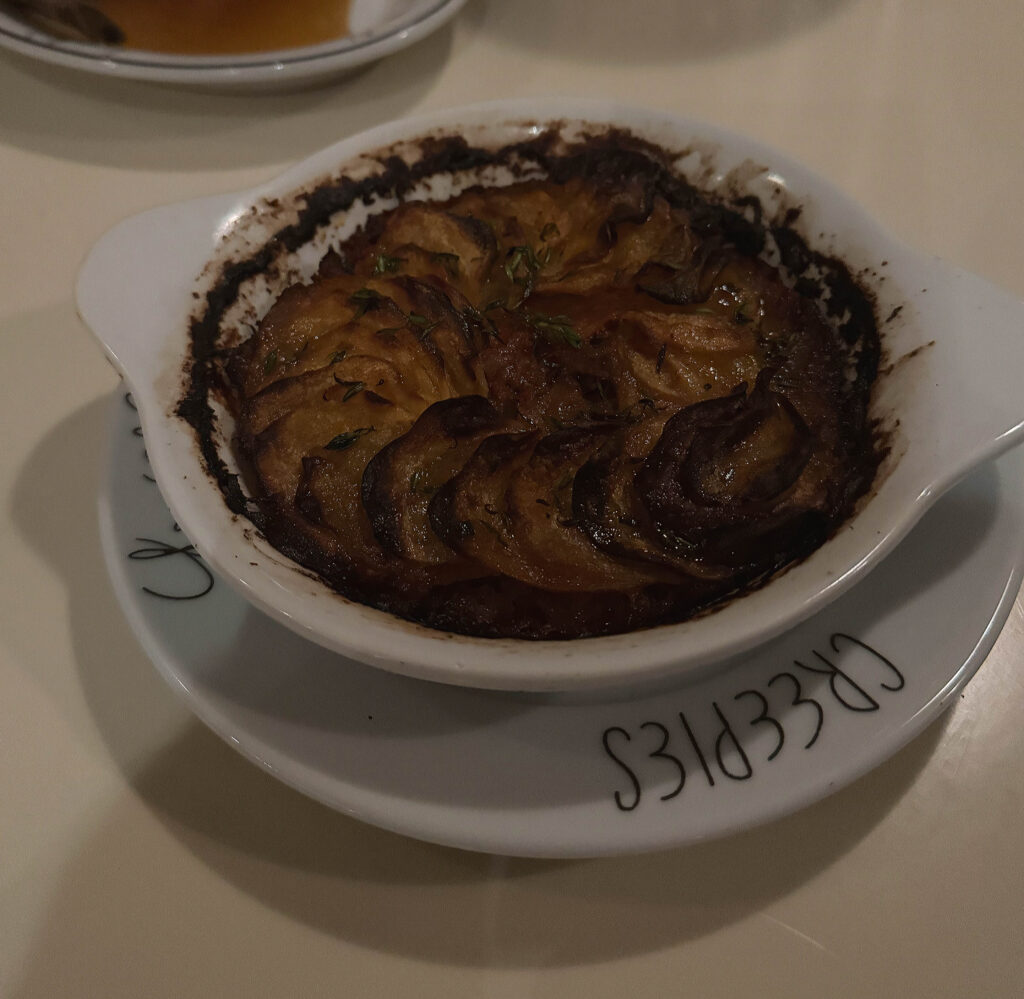
The “Pommes Ratatouille,” too, cannot hold a candle to its French-fried brethren. Certainly, the core idea here is sound: a spiral of crispy potatoes moistened and flavored by a diversity of stewed vegetables. However, while the dish arrives powerfully charred and appropriately crisped, its interior is a wet, vaguely tomatoey mess. Subsequent examples have pushed the charring of the pommes even further, but I’m not sure the ratatouille element will ever deliver the kind of richness and satisfaction a layer of melted cheese might provide. I’d like to be proven wrong though.
With the turn toward dessert, we now land in Anna Posey’s territory. Tonight, I sample all three of the creations on offer.
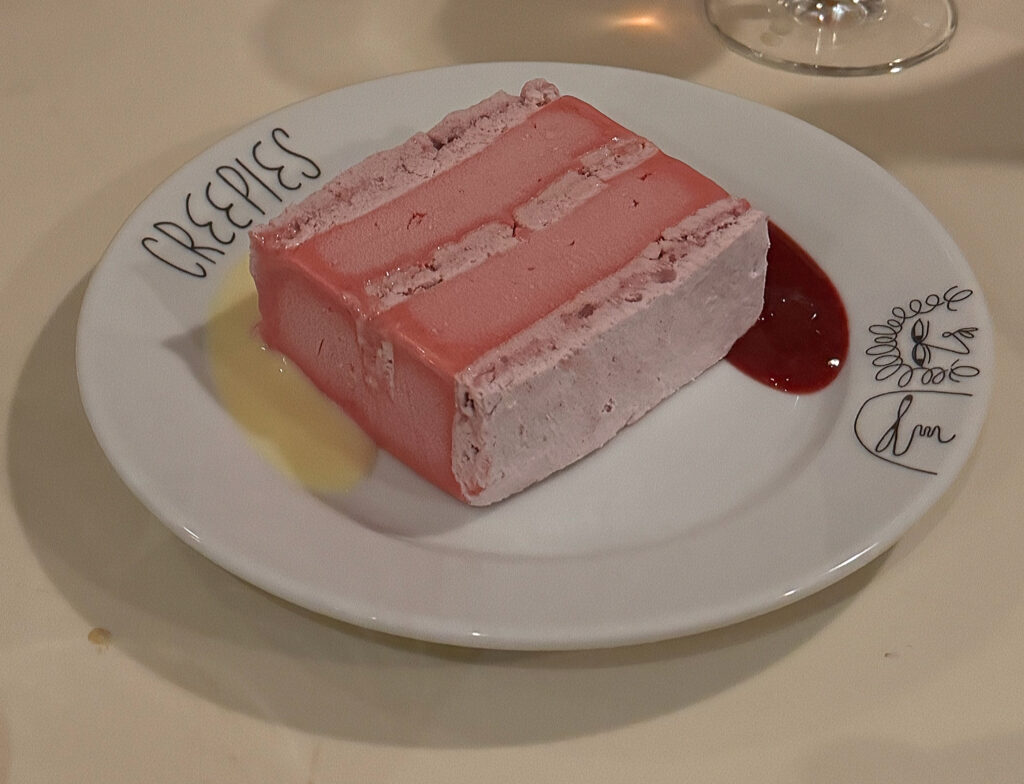
Of these, the “Raspberry Sherbet Meringue Cake with Buttermilk” ($14) is probably the most totemic. The pink, layered hues make sure of that, and I’m tempted to say this dish will end up looking better than it tastes. Texturally, the sherbet balances a creamy, melty consistency (free of jarring ice crystals) with firm, cookie-like slabs of meringue. The resulting flavor here is puckering on entry, turning richer and tangier with the incorporation of the buttermilk. Nonetheless, a deep sweetness reveals itself on the finish, and the length here—so satisfying—surpasses what I thought capable from a recipe that is so centered on fruit.
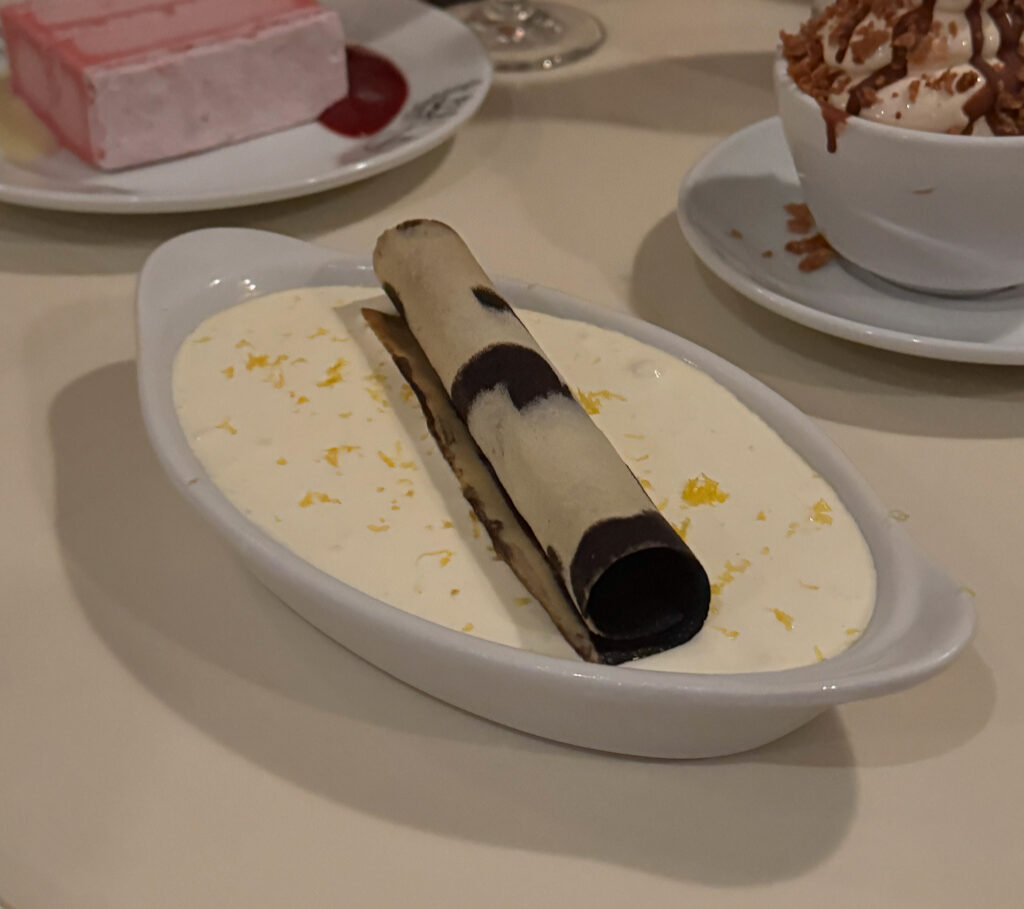
The ”Butterscotch Custard with Crème Fraîche and Lemon” ($14) goes in a more conventional direction. Topped with a crêpe-like tuile, the dessert almost seems to play things too safe: delivering a smooth, rich mouthfeel with a hint of crumbly contrast and citrus-tinged, caramelized tones. However, by the last spoonful, I come to appreciate how well the custard combines its actual airiness with perceived concentration on the finish. Indeed, the flavor of butterscotch here is immaculately, deeply rendered, and this recipe manages to deliver a surprising degree of decadence without any accompanying heaviness.
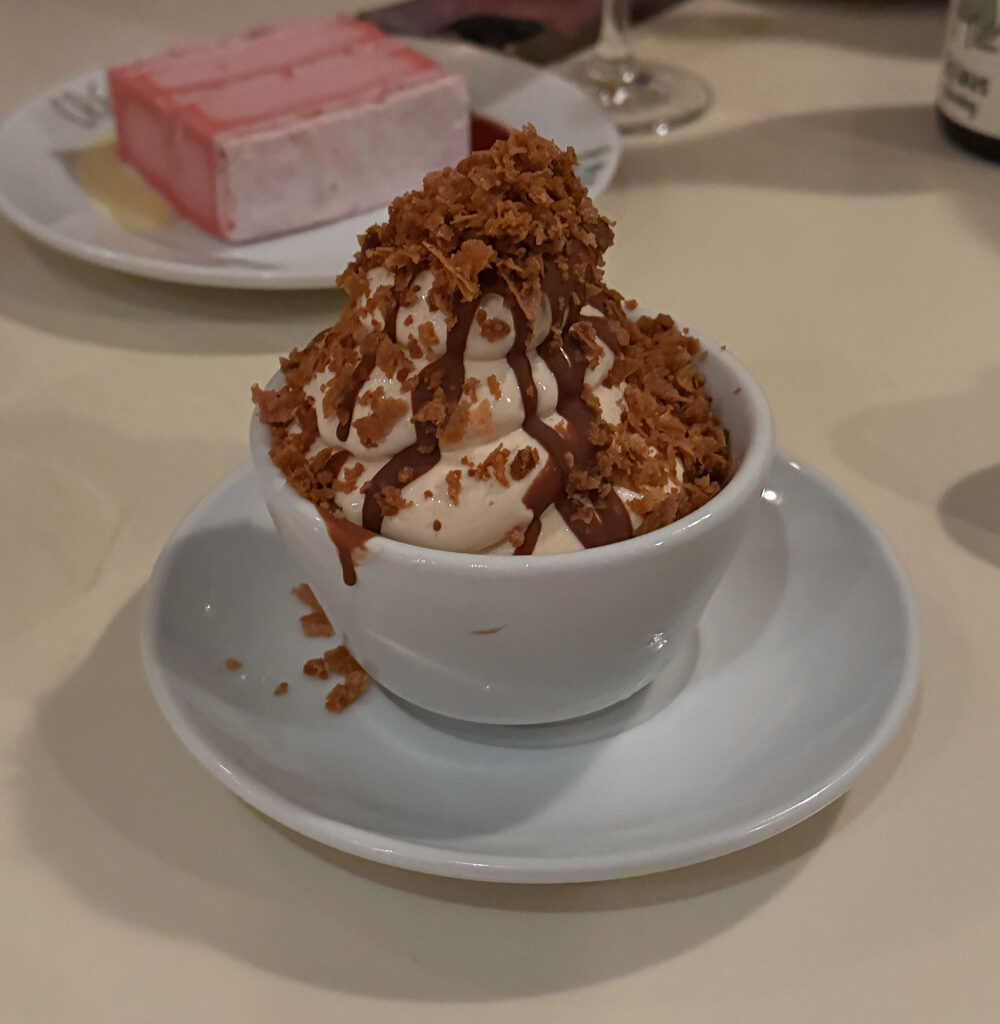
Arriving last, the “Baguette Soft Serve with Chocolate & Brown Butter Crumbs” ($12) is the most imaginative of the bunch. Though, in practice, I’m not sure I would ever identify the flavor of the ice cream as being “baguette” if I wasn’t told. Instead, this dish eats like a vanilla sundae with some darker, maltier undertones added. That said, the creaminess of the soft serve opposite the crisp, shell-like ribbons of chocolate and the flaky brown butter crumbs is beautifully composed. Yes, this is clearly the most hedonistic of the desserts, and it undoubtedly delivers.
At the same time, I do not think any one of these three recipes (their quality being hard to separate) is absolutely convincing at present. Rather, they’re all just “very good,” and I eagerly await a recipe (perhaps once weather conditions preclude frozen treats) that aims at greater warmth and comfort. Admittedly, this is not quite Posey’s style, but I’d like to encounter something that at least matches the sheer intensity of Elske’s hallowed “Sunflower Seed Parfait.”
With that, the meal reaches its conclusion: some 19 different dishes served in just a little over two-and-a-half hours (not counting the time it takes to get drinks and place the order). Though as many as three plates may hit the table at any given time (and some, like the “Bread & Butter” demand minimal effort), this is pretty phenomenal pacing for such a young restaurant.
When the bill arrives with its 4% “service charge” (“to offset rising costs associated with the restaurant”), I do not bristle. After all, the fine print clarifies that guests “may request to have this removed,” and it’s not like Elske and Creepies are part of one of those gargantuan hospitality groups that are already well positioned to compete in this marketplace (and, thus, should know better than to nickel-and-dime their longstanding customers).
If a 4% premium (also assessed next door) keeps the staff happy and secure, I welcome it. If it helps Creepies compete with concepts in West Loop that lack any of the same connection to the community, I doubly do so.
Even if I am more conscious of the restaurant’s faults than many people walking through the door at this early stage, it takes nothing away from my admiration. Pursuing something new and bold and a little different means contending with the resulting missteps.
Yes, when I retrace my path through the buzzing dining room and past the would-be guests who are still angling for a table, I think of how lucky the team is to have cultivated an audience who is willing to go along for the ride.
Creepies, nearly two months in, doesn’t need to be perfect so long as the team preserves its capacity to dream. From my perspective, the kitchen’s big swings—and big misses—are infinitely more exciting than what other chefs have dared to open this year. If I’ve learned anything from my favorite restaurants, it’s that it’s much easier to troubleshoot recipes and sharpen execution over time than it is to inspire a creativity that was never there to begin with.
In ranking the evening’s dishes:
I would place the “Tarte Flambé, Tavern Style” and “French Fries” in the highest category: superlative recipes that stand among the best things I will be served in any restaurant this year.
Next come the “Warm Brie Gougères,” “Tomatoes & Grapes with Crispy Tapenade & Labneh,” “Steamed Mussels,” ”Corn Crepe, Summer Succotash & Green Tomato,” “Roasted Chicken,” “Roasted Lamb,” “Raspberry Sherbet Meringue,” ”Butterscotch Custard,” and “Baguette Soft Serve”—very good—even great—preparations I would always be happy to sample again (but that just failed to elicit an extra degree of emotion). Of these, the “Tomatoes & Grapes,” “Roasted Chicken,” and “Baguette Soft Serve” came closest to reaching that higher level.
A step lower, one finds the “”Bread & Butter,” “Saucisson with Puff Pastry & Pistachio,” “Crudités with Horseradish & Brown Butter,” “Shishito Peppers with Breadcrumbs & Mimolette,” “Fluke Tartare ‘Gribiche’,” “Cod Meunière with Endive,” “Parisian Gnocchi,” and “Pommes Ratatouille”—merely good (maybe just average) items that fell short when it came to texture or flavor. None of these bites faltered in more than one dimension, so there was still pleasure to be had (and, indeed, they could all easily be fixed with a little more tweaking).
Finally, we have the “Tomatoes & Peaches with Crispy Tapenade & Labneh” and “Little Gem with Zucchini & Sunflower Seeds”: two dishes that were clearly flawed across multiple dimensions and that I would not order again barring clear changes. (As it happens, both of these recipes have already been dramatically altered.)
This makes for an overall hit-rate of 52% across my third and fourth visits. It’s scary number, no doubt, but one that should be contextualized given the fact that preparations like the “Saucisson” or “Shishito Peppers” may very well please diners who are not attuned to how their execution has faltered over time.
Plus, I think it sounds much less dire to say that more than half of what Creepies is serving on its 23-item menu is of “best of the year” or “would be happy to sample again” quality. For a young restaurant and a kitchen that (rather than playing the hits) is looking to put a clear creative stamp on every piece of their work, I think this is a real achievement.
Nearly a decade on, Elske still serves food that I struggle to wrap my head around. I love them for it, and it’s by so finely balancing provocation and weirdness with evergreen, absolutely world-beating offerings that the concept has carved out a singular place at the very top of the dining scene.
Creepies, from the moment of opening, struck me as being cut from the same cloth. It enjoys all the obvious structural advantages that top culinary and beverage talent bring to the table. It propagates a winning approach to hospitality—effortless but obsessed with the details—that has already earned Michelin’s approval. It adapts them all with a new breeziness, a different mood, a little more value, and, thus, seizes the opportunity to bring this team’s vision to a wider audience than ever before.
I actually never ate at Elske in its first year of operation, so I cannot speak to what growing pains they, too, might have faced. By the time I arrived, I could rely on the restaurant’s signatures dishes as they still are (with minor variation) today. I could appreciate the experimentation and the misses (which still tasted unlike anything else I had ever encountered) because they were sprinkled atop such a strong core of satisfaction.
Creepies, really, is so close to being that same kind of place. Order the “Gougères,” the “Steamed Mussels,” a “Tarte Flambé,” the “Roasted Chicken,” and “French Fries” (as well as any cocktail, wine, or dessert) and one can already have a pretty memorable meal.
If the kitchen refines the texture of the “Bread & Butter,” fixes the puff pastry on the “Saucisson,” intensifies the dip served with the “Crudités,” and melts the cheese more consistently on the “Shishito Peppers,” they’ll be putting out a menu whose actual pitfalls are few and far between.
This is the first step, and I have full faith the team will take it. They’ll form a foothold from which any one of their recipes (so valuable is the creative thought behind them) can, with further and further iteration, rise to a place among the city’s best.
The idea here is never to compete with a Le Bouchon or an Obélix (it feels unfair even to mention their names) in a battle littered with butter and duck fat. It’s about fostering a culinary voice that has something meaningful to express in a genre where everything, seemingly, has already been said. It’s also about reminding a neighborhood, so in the grip of expansion, that this kind of cooking still matters—that it can surprise and delight with just a small change in perspective.
Four visits in, I think that’s how Creepies needs to be approached (certainly through the two-month mark and maybe even beyond). It’s a restaurant that has chosen the harder path of pursuing distinction rather than channeling its efforts toward offering immediate reward. It’s a place, too, that demands collaboration from its customers in this process of actualization.
However, time has taught me that this path—with the right support and capacity for self-reflection—is well worth taking. It’s the only means of creating a timeless concept: one whose gifts only grow with time. And it’s the only way that the magic of Chicago’s dining scene can be restored.


